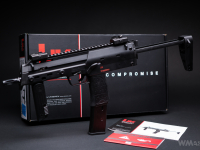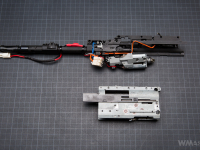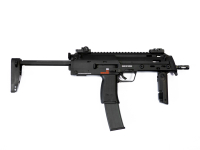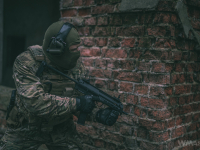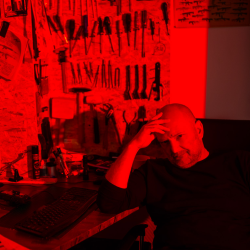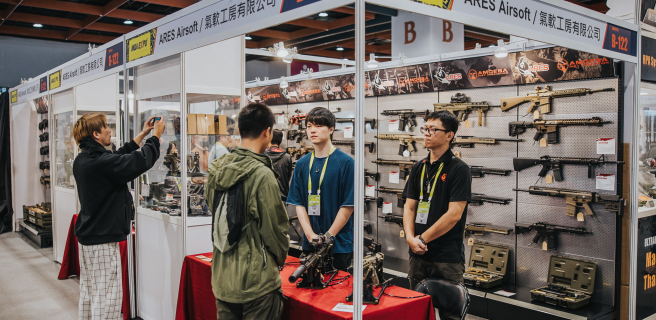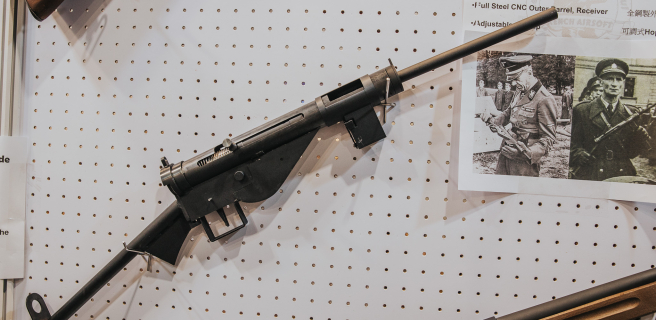The history of the MP7 submachine gun begins in 1999, when HK presented a prototype weapon chambered for a new 4.6x30 mm round, designated as the PDW2000 (Personal Defense Weapon). It was probably the first design in this class of weapons, which used a side gas port in the barrel - i.e. a system used for years, but in assault rifles and carbines. There was even more "heresy" as the design borrowed solutions from the G36 rifle was a simultaneous abandonment of the semi-rigid bolt used by HK in G3 rifles and the queen of submachine guns, the iconic MP5. The PDW2000 project was developed for several years and finally the HK MP7 was presented in 2001. Subsequently, small quantities of this weapon we issued in 2002 to commandos from the KSK (Kommando Spezialkräfte), a German military unit that is more or less the equivalent to Polish GROM or the American Delta Force. Based on subsequent tests and comments from KSK soldiers, the MP7A1, whose electric powered replica is being tested today, was finally shown to the public by the end of 2003.
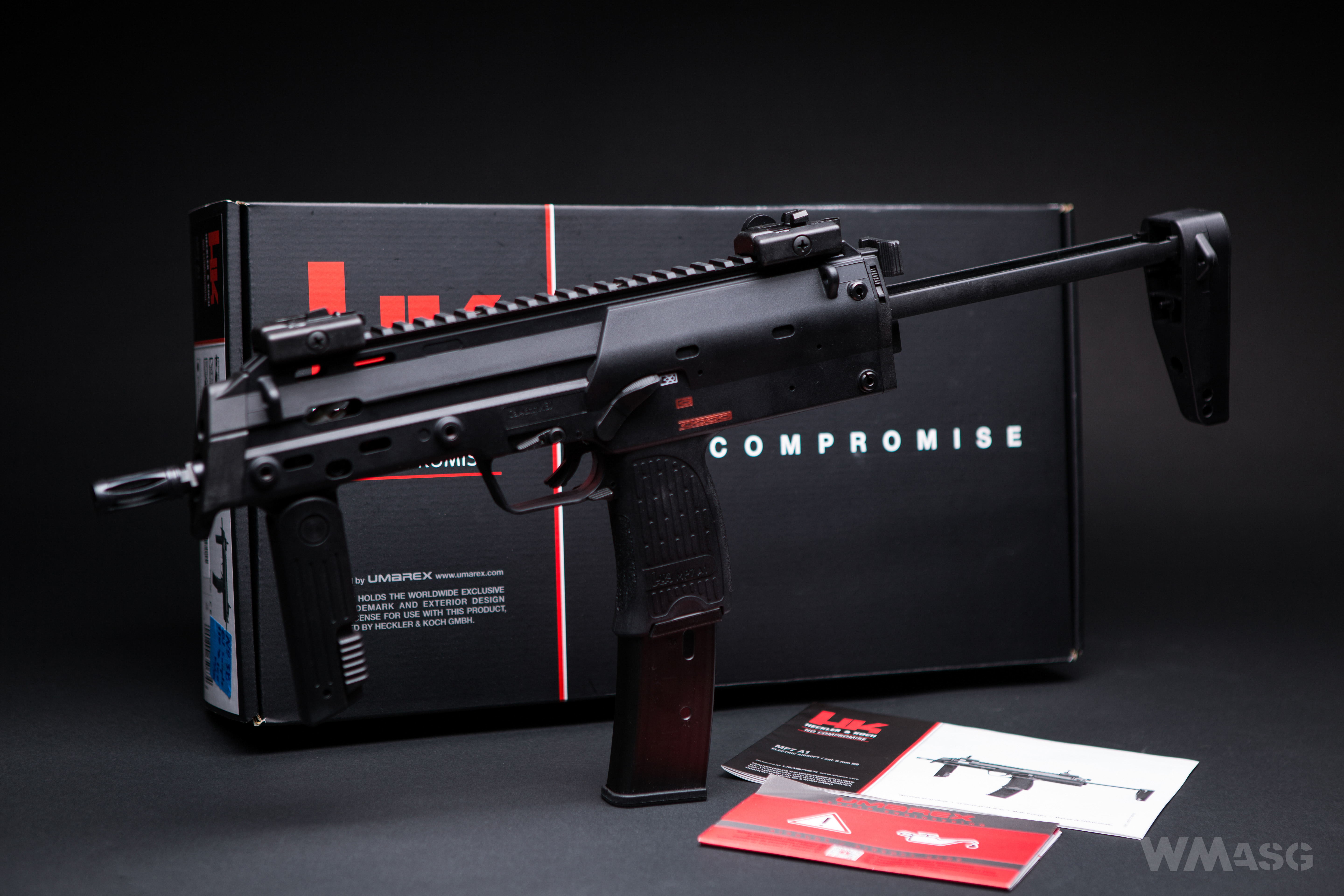
The presented replica is not the only one available on the market. There are gas powered (GBB) versions, including also HK licensed models made by VFC. There are also electric powered versions like the AEP replica produced by Well (with pistol like performance and muzzle velocity of about 200 fps). The copy described below is a fully licensed replica with markings compatible with the real SMG. The official manufacturer is Umarex but the MP7A1 replicas are physically made by VFC in Taiwan. In the United States, the twin model (also made by VFC) is sold under the Elite Force/Umarex brand. However, the most important feature of the replica tested here are not licenses or the markings that are true to the original. The most important thing are performance parameters far exceeding AEP and GBB models. In other words, in CQB games it is the MP7 that is perfect as a primary weapon.
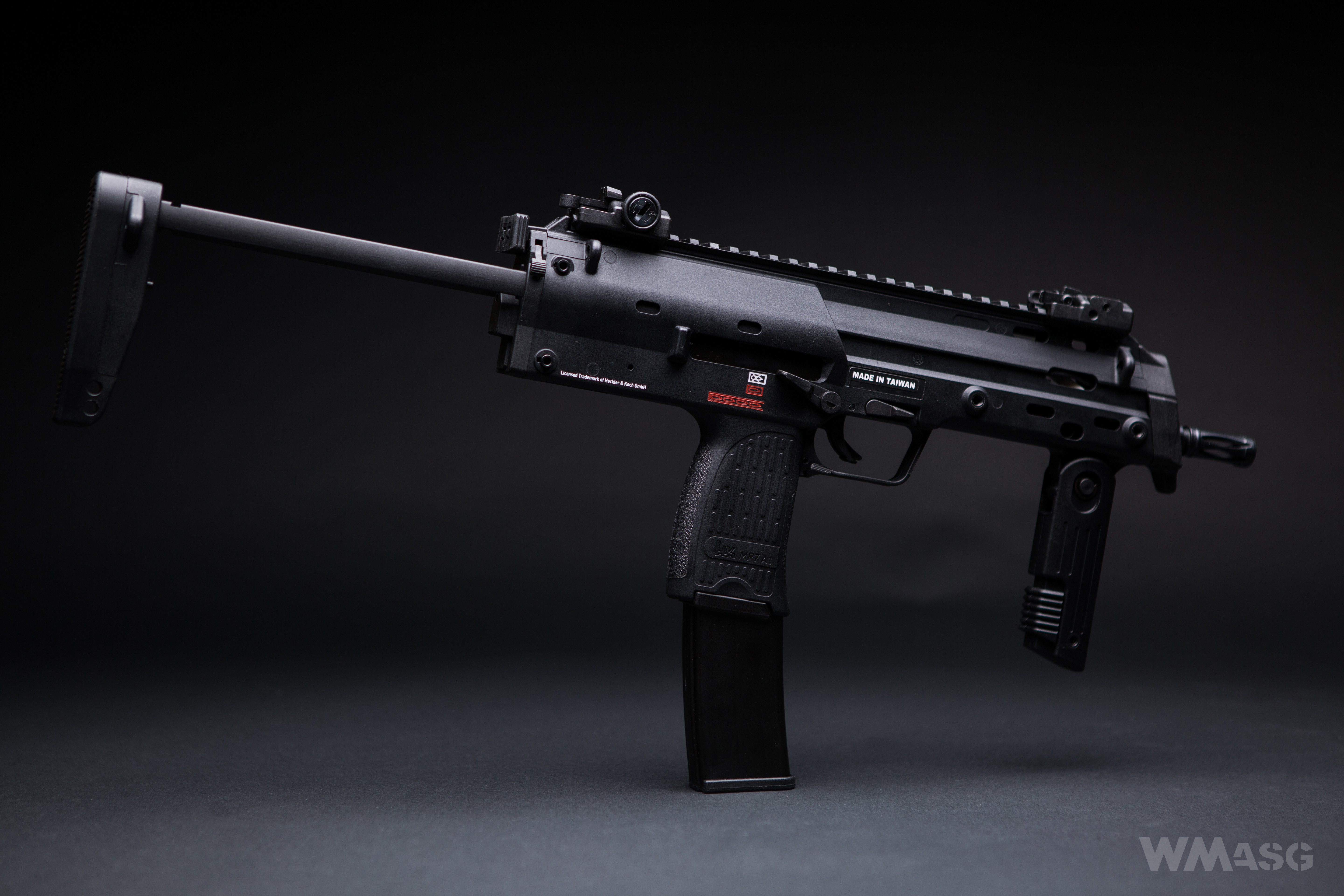
Basic technical parameters:
- overall length (collapsed/extended stock): 420/640 mm;
- weight (without the battery, with an empty magazine): 1658 g;
- inner barrel length: 200 mm;
- magazine capacity: 120 BBs;
- muzzle velocity: 330 fps.
Available fire modes: single and full-auto. The replica stops firing when the magazine is empty. The mechanism does not work without an inserted magazine. In other words, everything works only when the magazine with BBs is inside the replica.
Along with the replica, we only receive detachable folding sights, a mid-cap magazine (for 120 BBs) and a printed instruction manual.
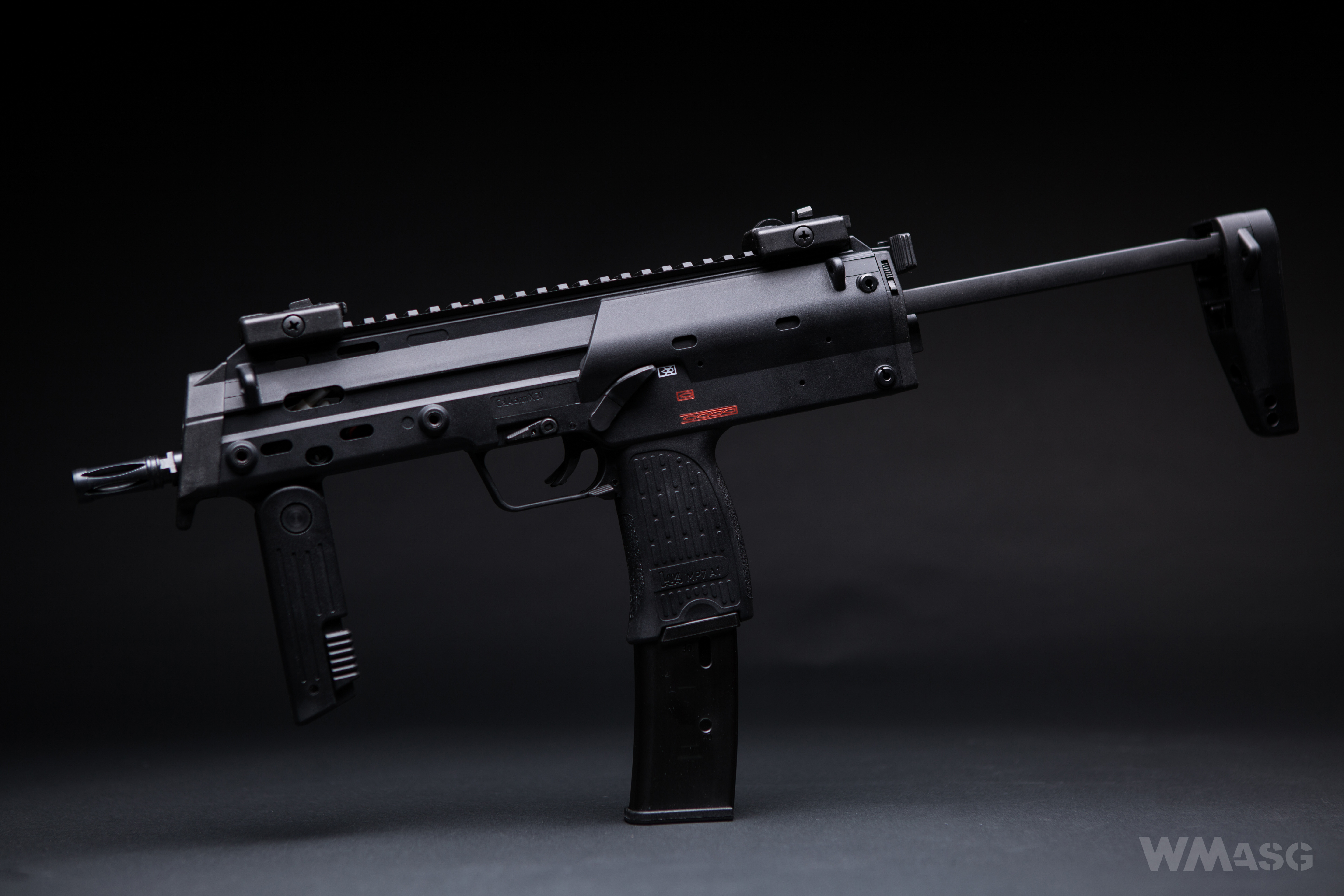
From the outside
In short, the gun just looks good and "reliable". Thanks to CENZIN we had the opportunity to compare it 1 to 1 with the real thing. Of course, the replica is not made of carbon fiber reinforced polyamide, but the material used is very similar to it.
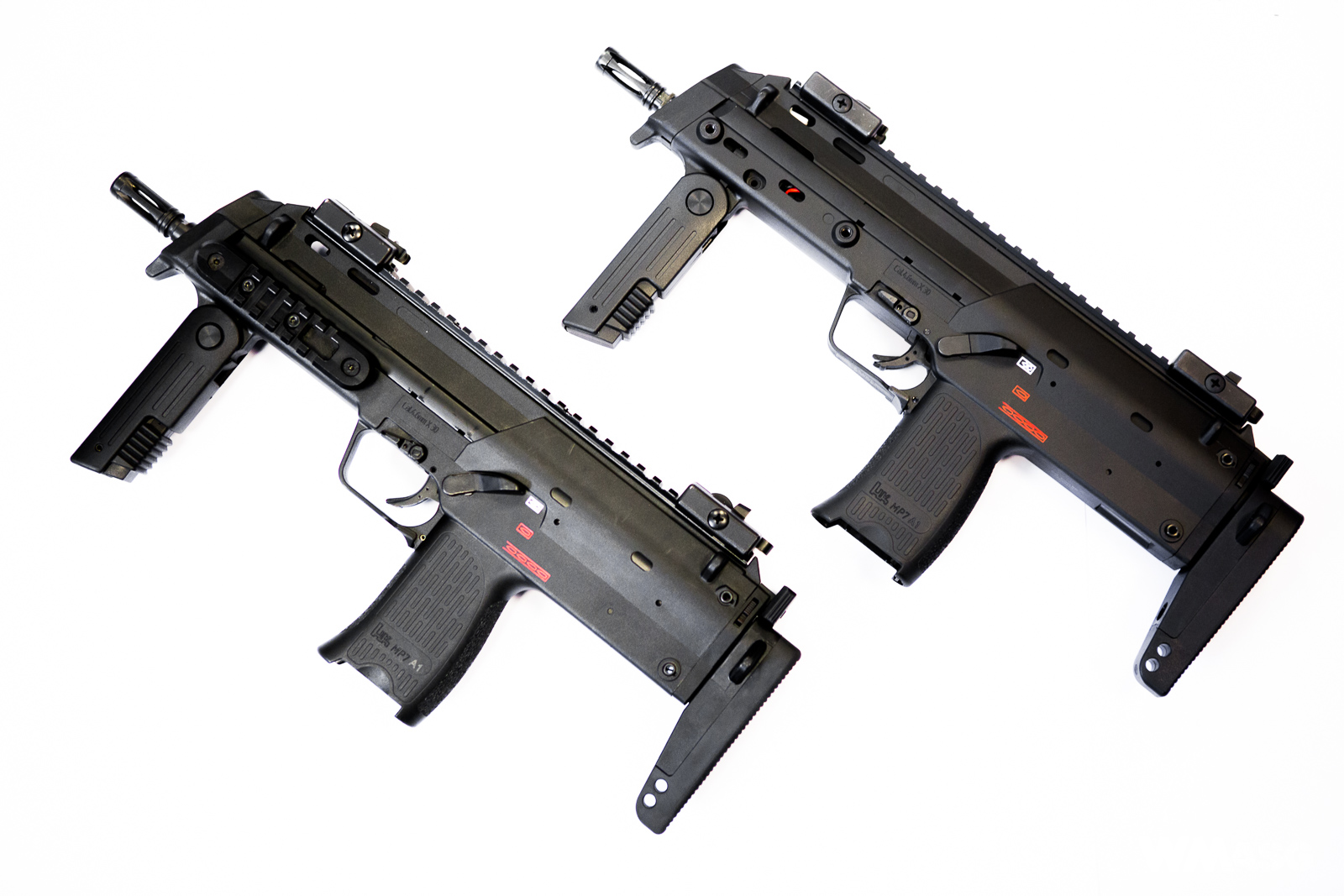
On the left, the real deal, on the right the latest MP7A1 replica by VFC
The whole is perfectly assembled and fitted. Despite the mostly polymer made parts, the replica is unexpectedly rigid. The places of joining (gluing) of individual parts are visible and can be felt under one's fingers, but they do not obstruct in anything, and above all, they do not have any mold marks.
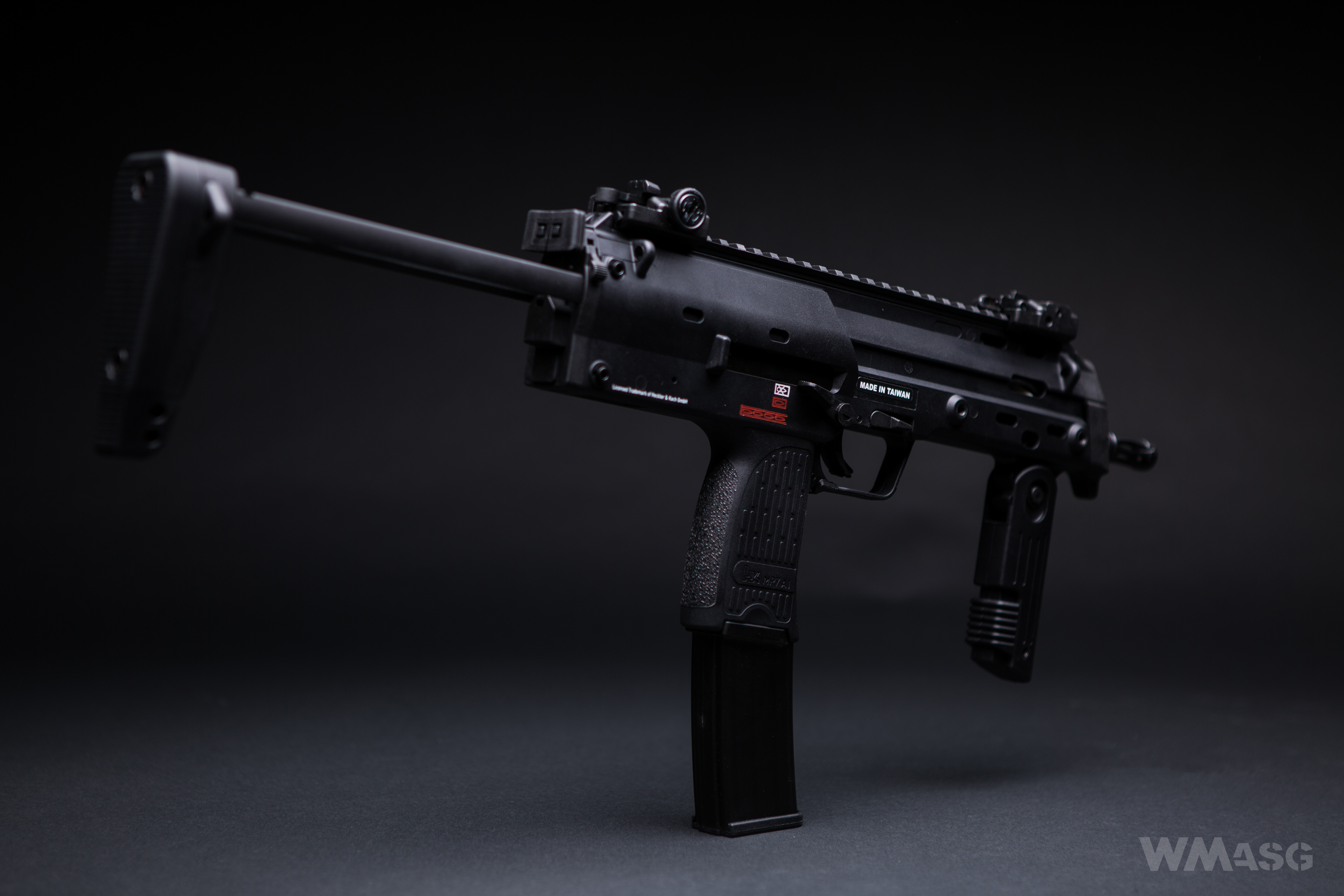
The design
As I mentioned above, almost the entire SMG is made of polymer. The top Picatinny rail is made of metal along the entire length of the weapon, as well as the detachable sights mounted on it, the flash hider, the manipulator switches and the stock guides. The dummy bolt closing the ejection port is also metal. Other metal parts, including threaded screw hole reinforcements or structural parts are embedded in the material and basically cannot be seen at first glance. The replica is modly monolithic, i.e. the handguard, the pistol grip and the receiver are molded as one solid piece. Only the battery cover closing plate can be opened/detached. But more on that later.
In the original, the weapon is adapted for use by right and left-handed shooters. Of course, it's the same in the replica. The main safety/selector switch is located next to the trigger and marked in a simple and legible way.
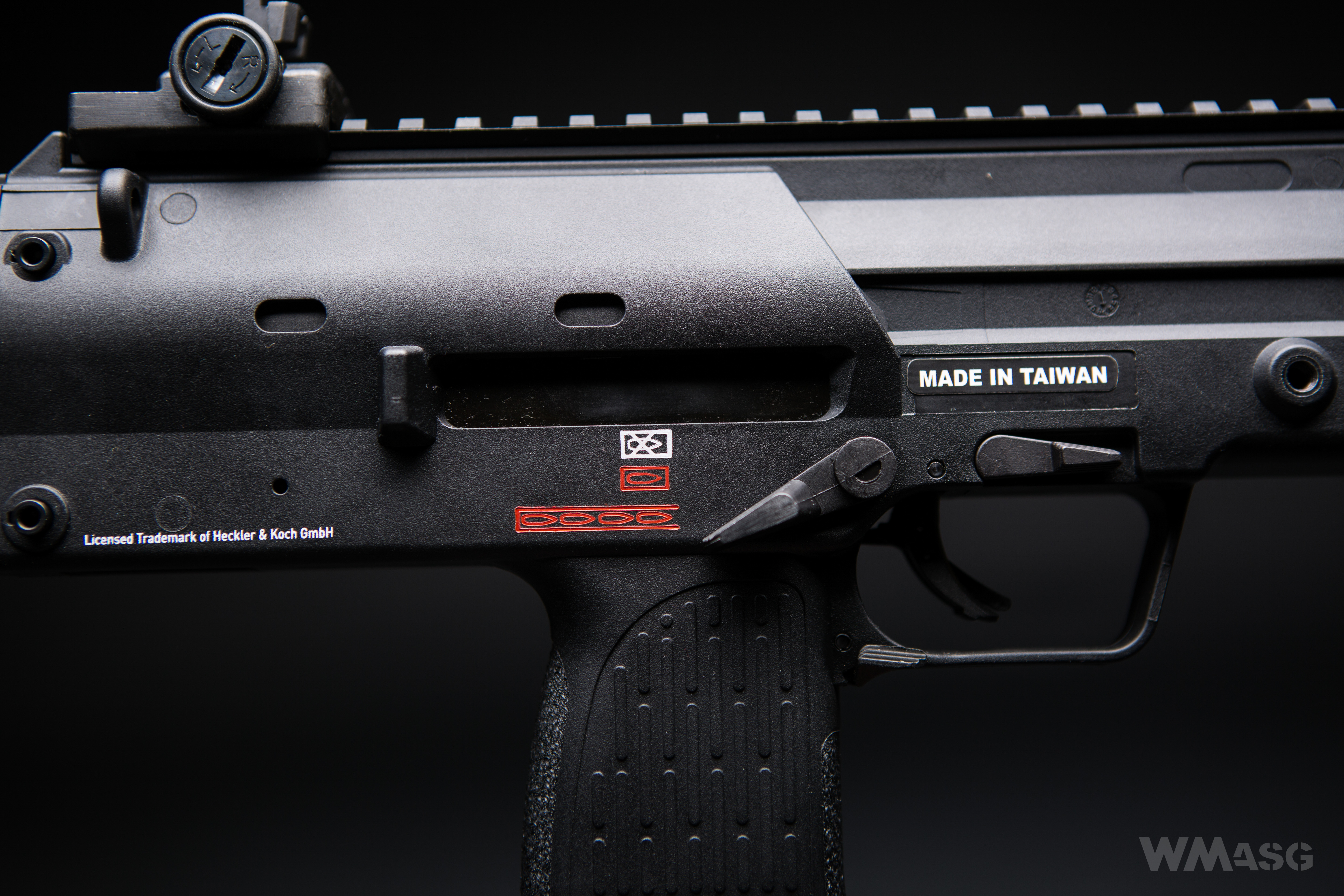
Slightly more to the front is the bolt catch lever. On the trigger guard, right next to the pistol grip, there is a magazine release lever. This is a solution that MP7 borrowed from pistols (e.g. Glock or USP).
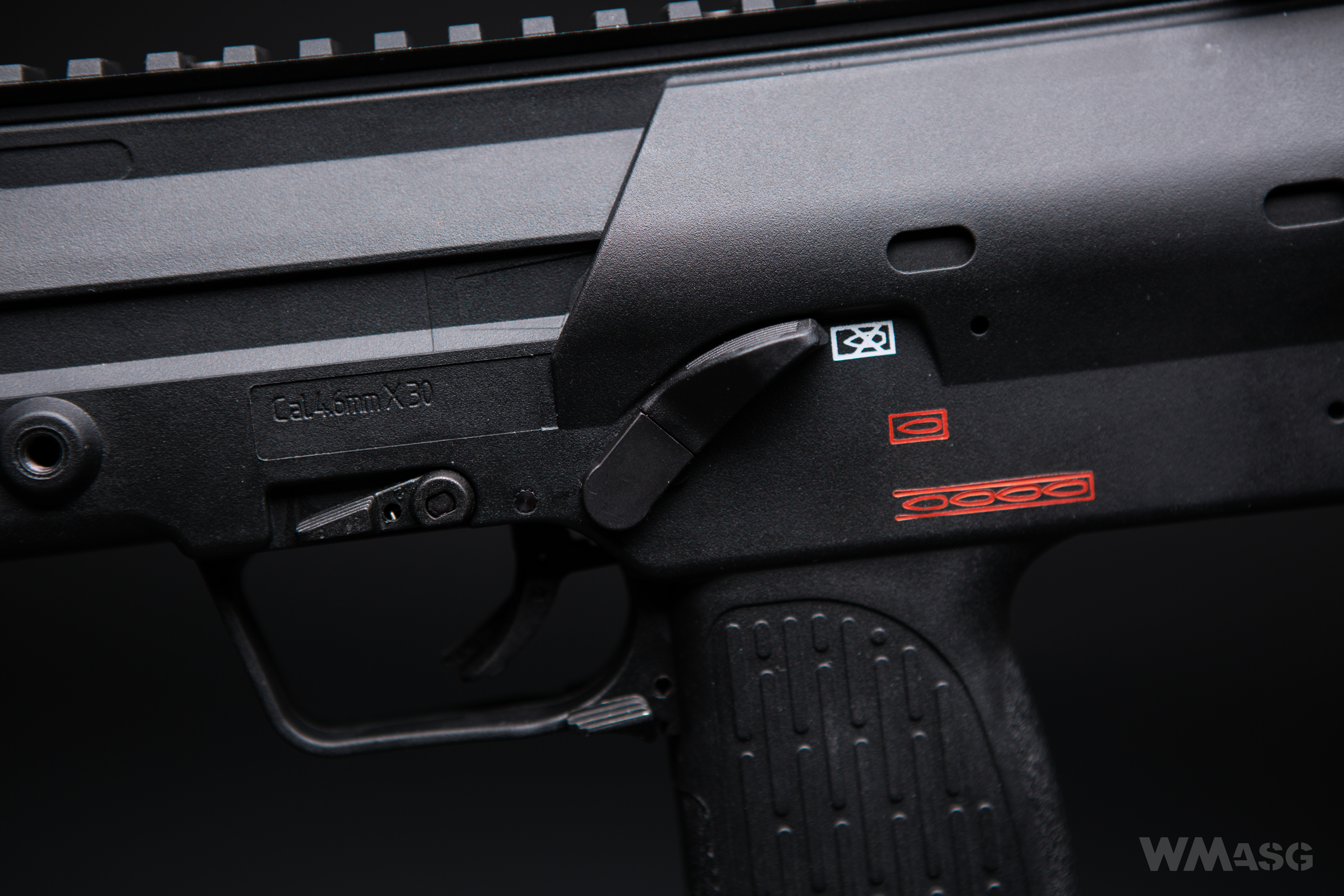
Another "borrowing" from the Glock is an additional safety feature located in the trigger. In the original it works a bit differently, but it is also functional in the replica. The trigger can not be pulled even after turning the safety off if the finger is not lying properly on the trigger.
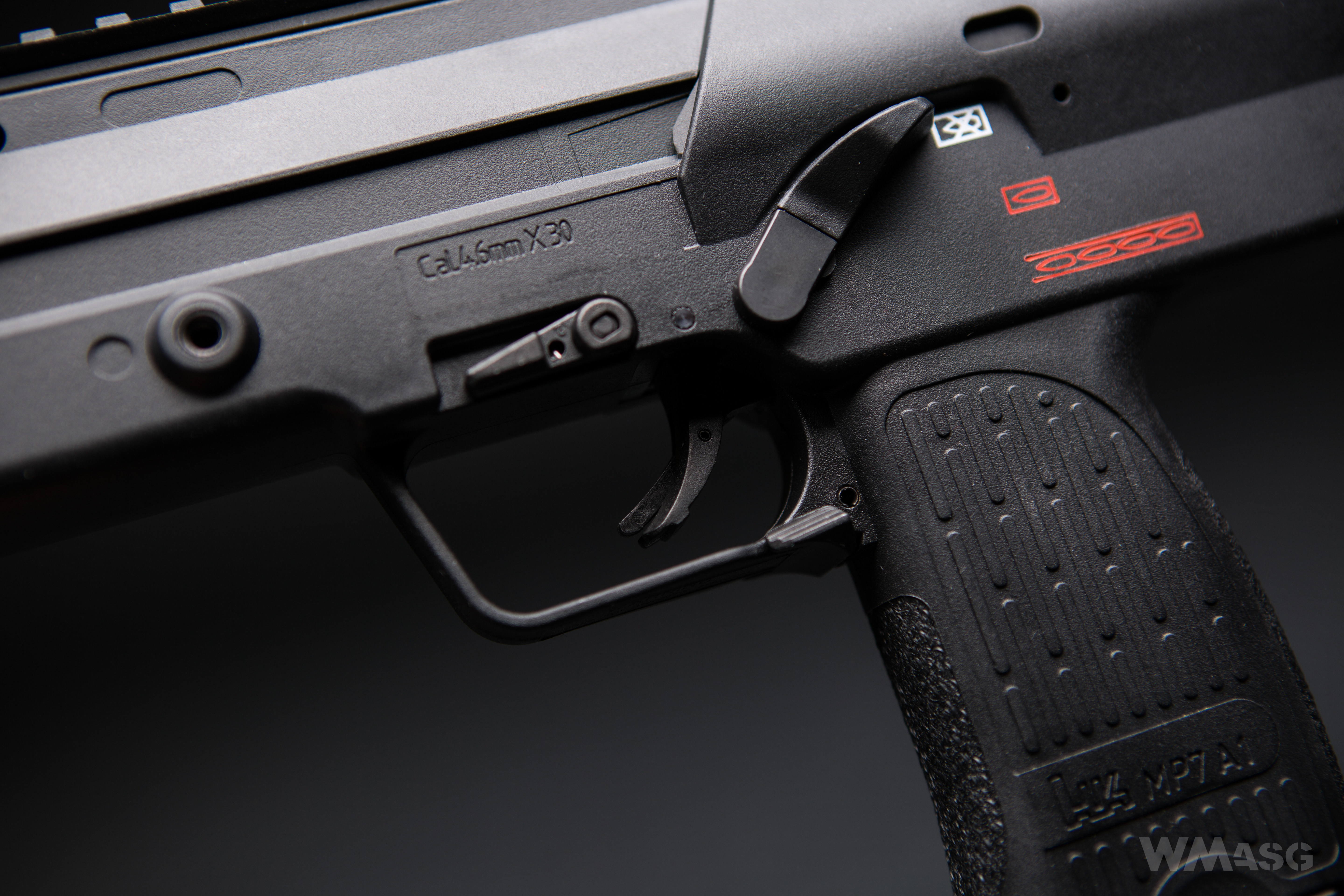
The same part in the real gun:
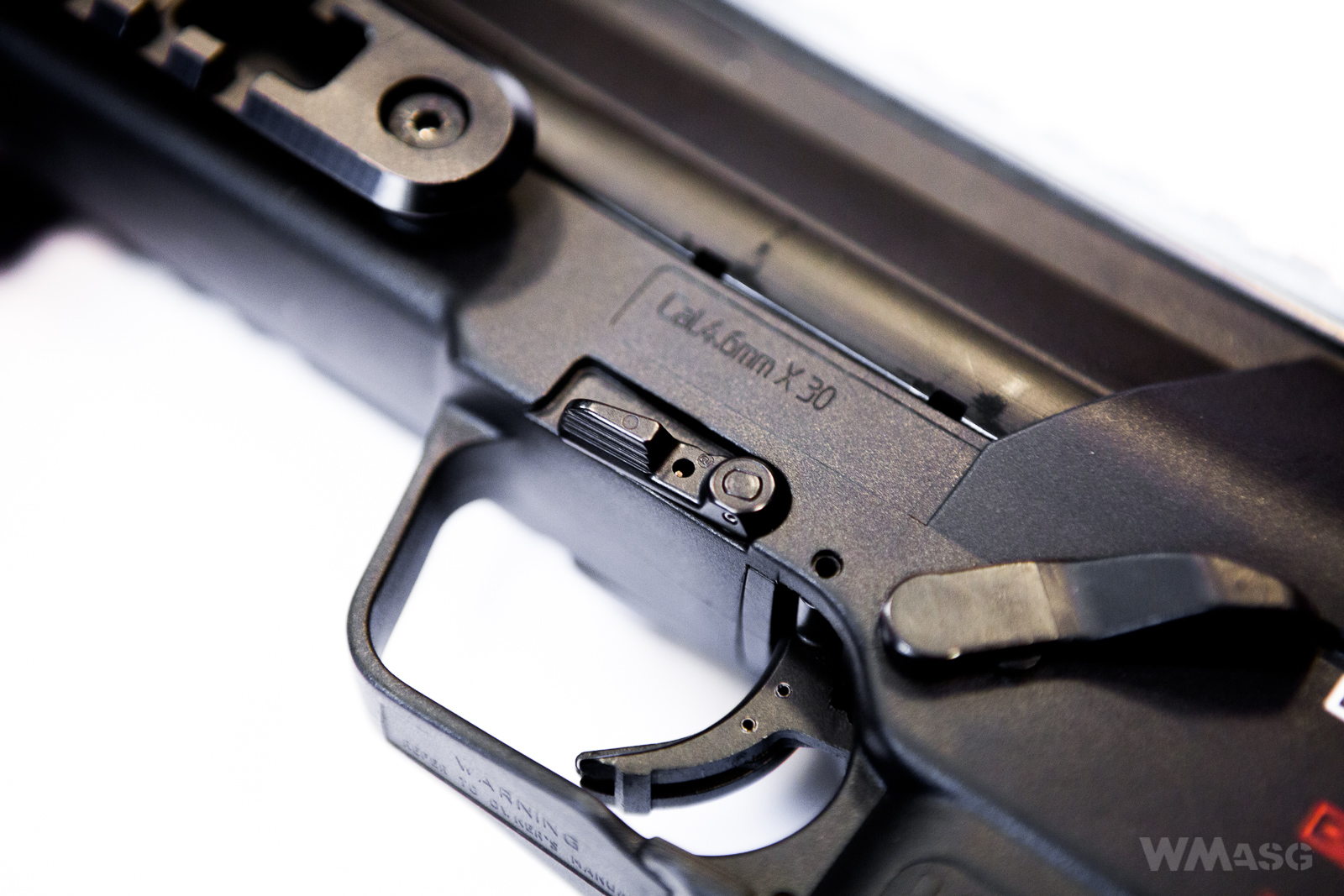
And since we're here, the pistol grip has the HK logo and characteristic undercuts, whose function is to facilitate the magazine exchange:
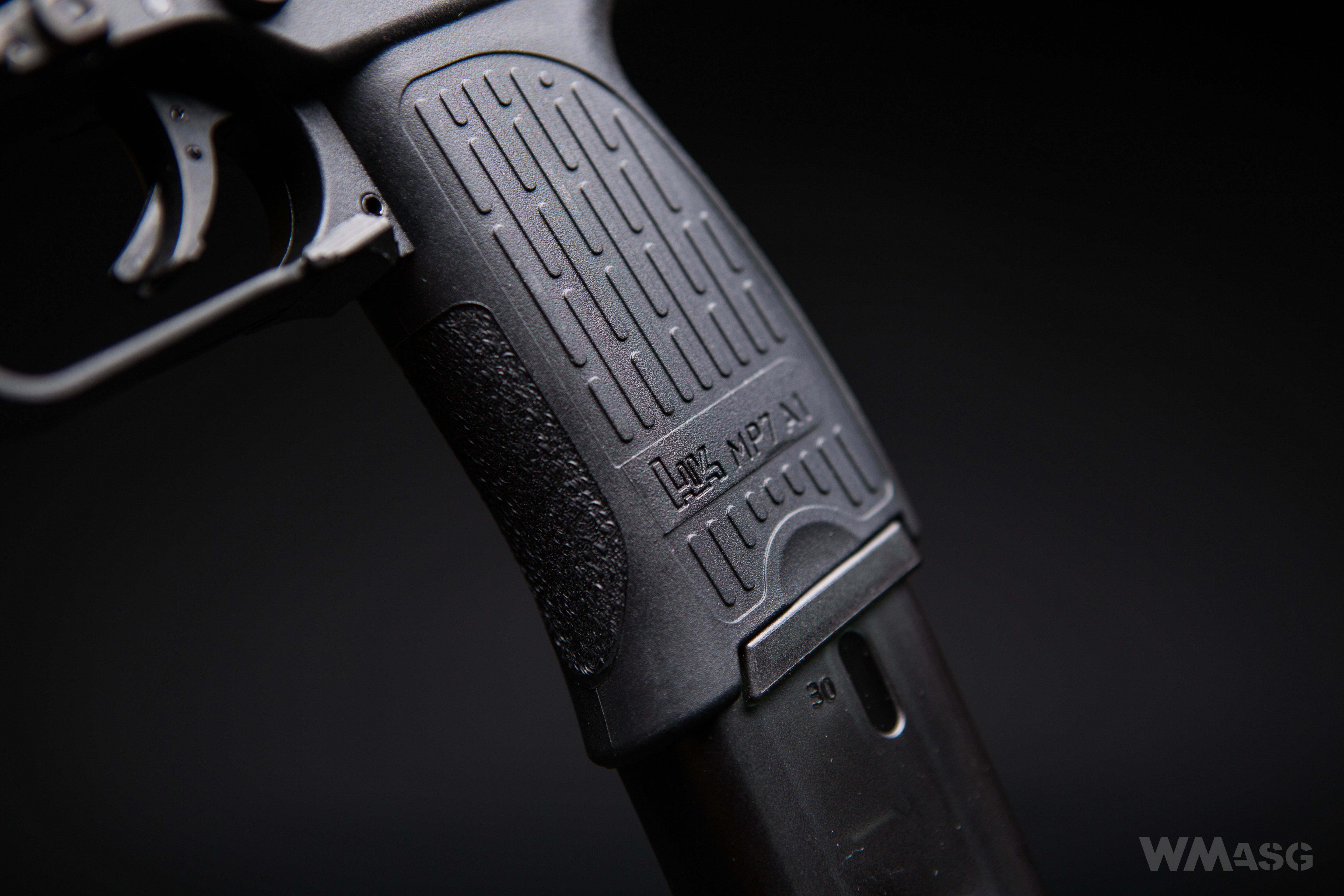
And the real SMG:
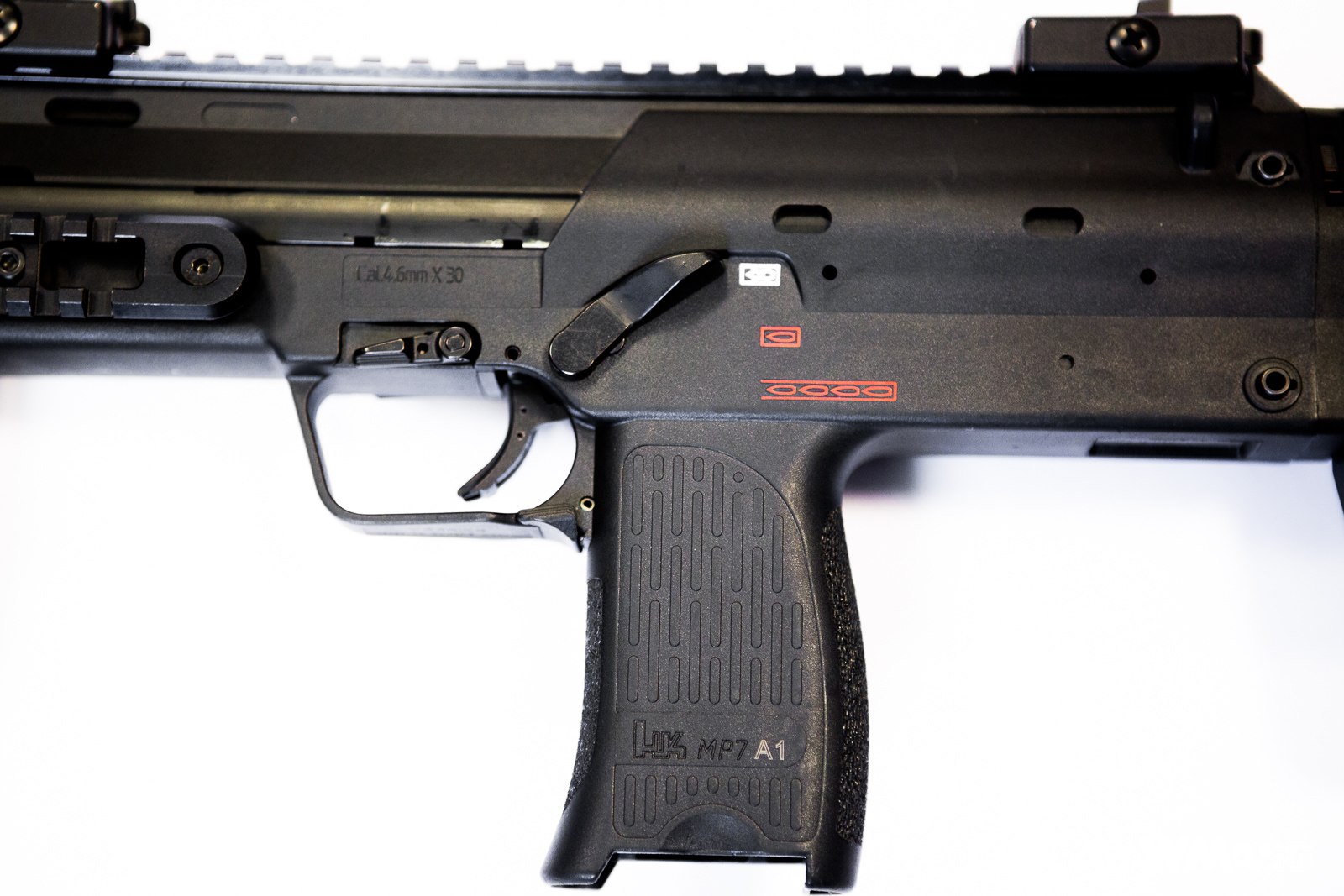
Other manipulators, i.e. the charging handle and the button for adjusting the stock length are located in the upper part of the receiver, at the rear. The red arrow indicates the lever and the direction in which it must be moved to adjust the stock. The visible lever is for adjustment only. On the left there is an additional one, whose simultaneous movement allows you to completely pull out the stock and disconnect it from the replica (the second photo below).
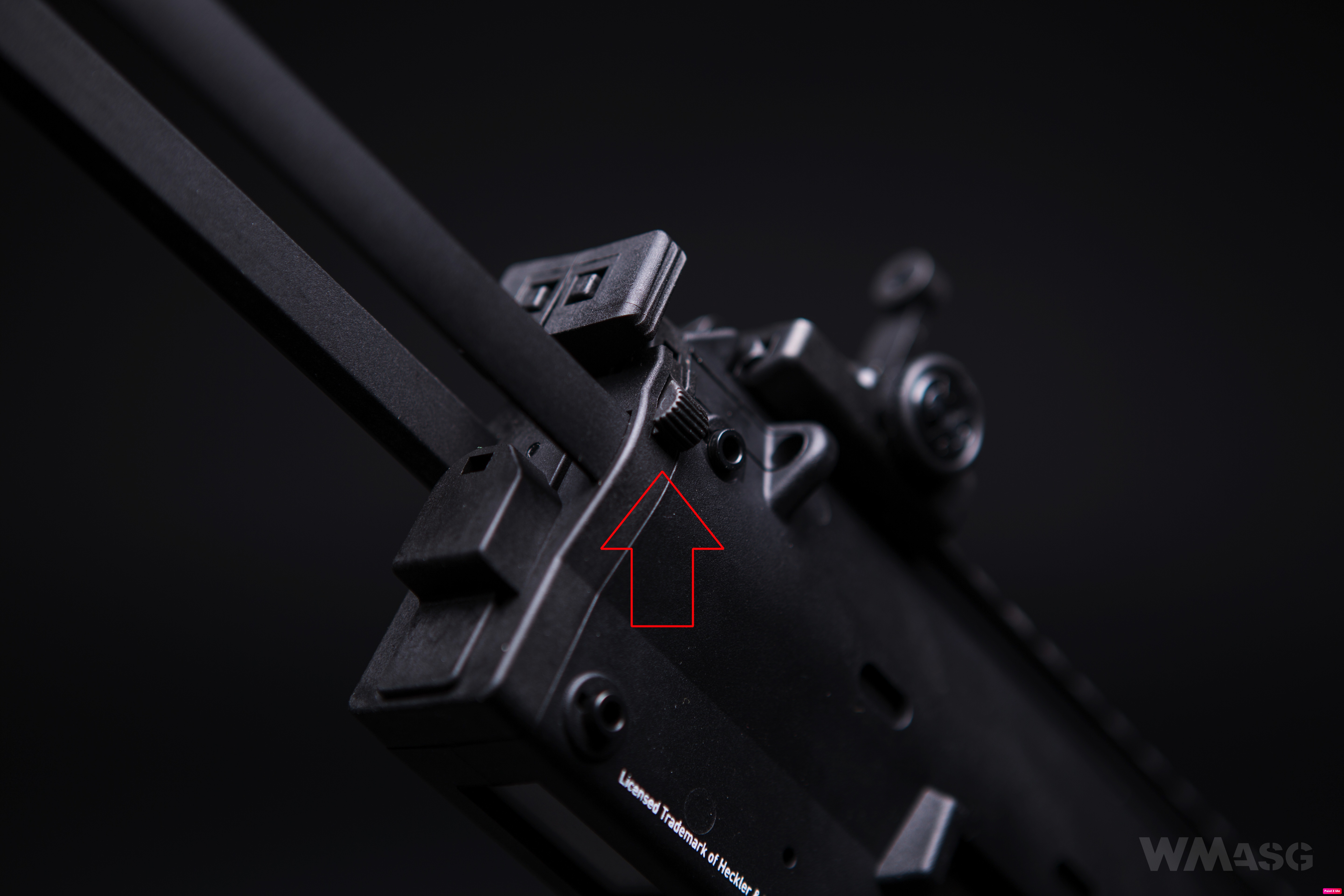
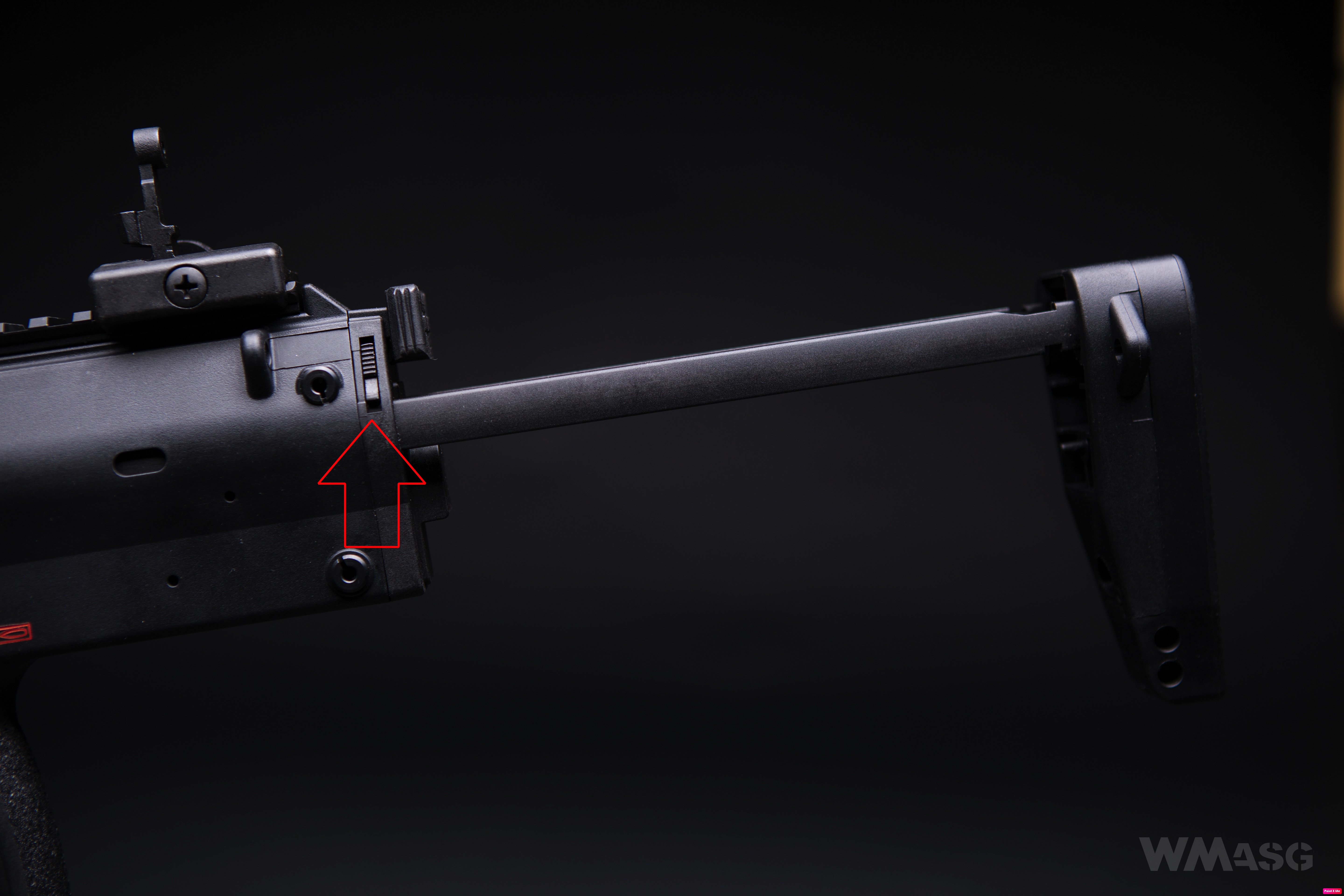
The horizontal red arrow shows the charging handle, which in the replica is used to open the ejection port when HopUp adjustment is needed. When the lever is pulled back, the dummy bolt remains in the rear position. The lever itself has no spring and when the dummy bolt locks in place, the lever must be pushed back.
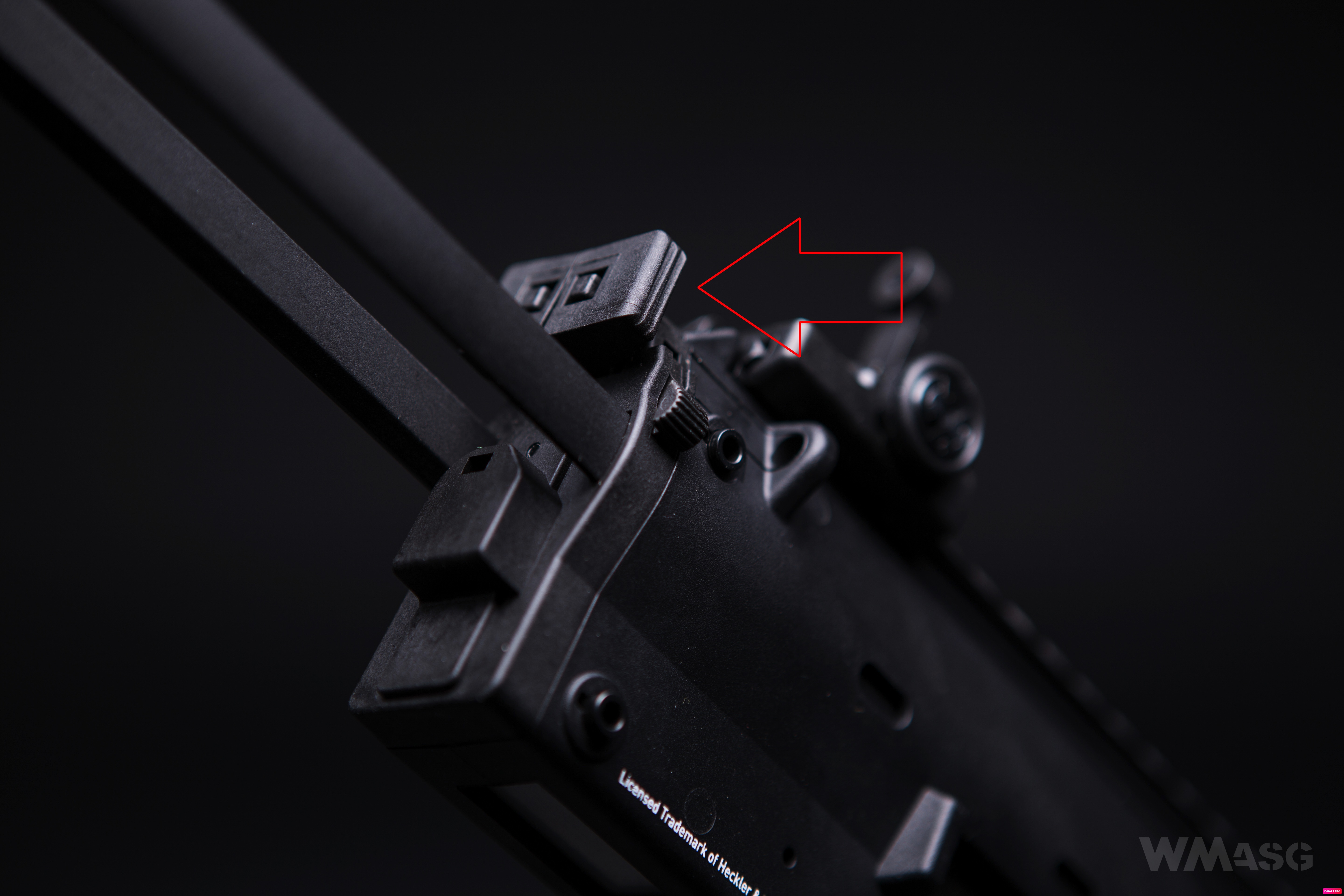
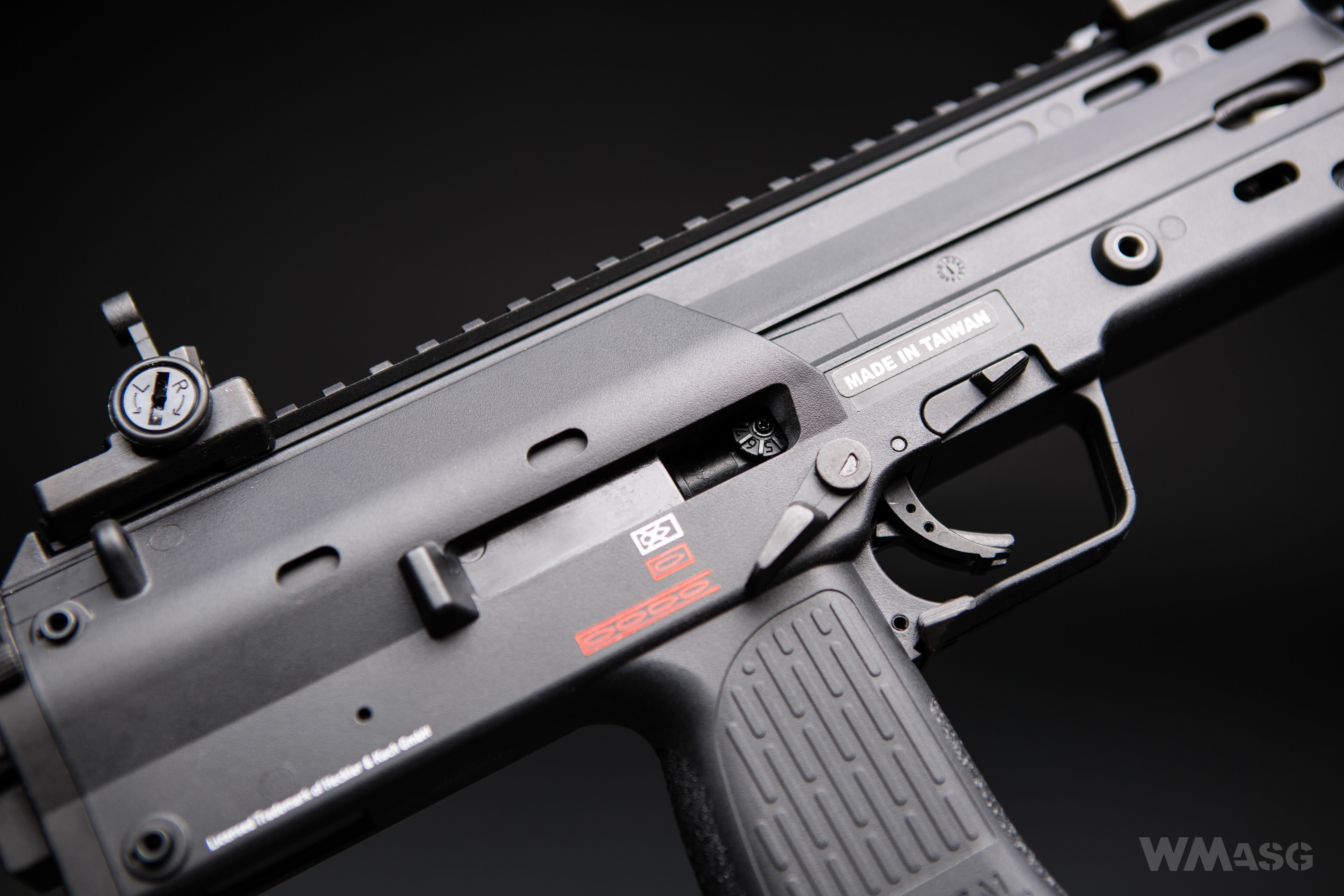
Access to the HopUp adjustment is not the most convenient, but one can live with it. After adjusting the system, one has to press the bolt catch and then the dummy bolt will return to the front position closing the ejection port. Unfortunately, in the tested unit it didn't worked so well. That is, out of the box it worked in such a way that the port never closed completely, you had to slightly pull the charging handle and push it forward again. After disassembling and assembling the replica the situation has slightly improved, but it still does not work flawlessly. I have the impression that the copy I tested came to us after some other tests and disassembly, as a result of which the sliding mechanism of the dummy bolt was slightly damaged. But I will write about it in the technical part.
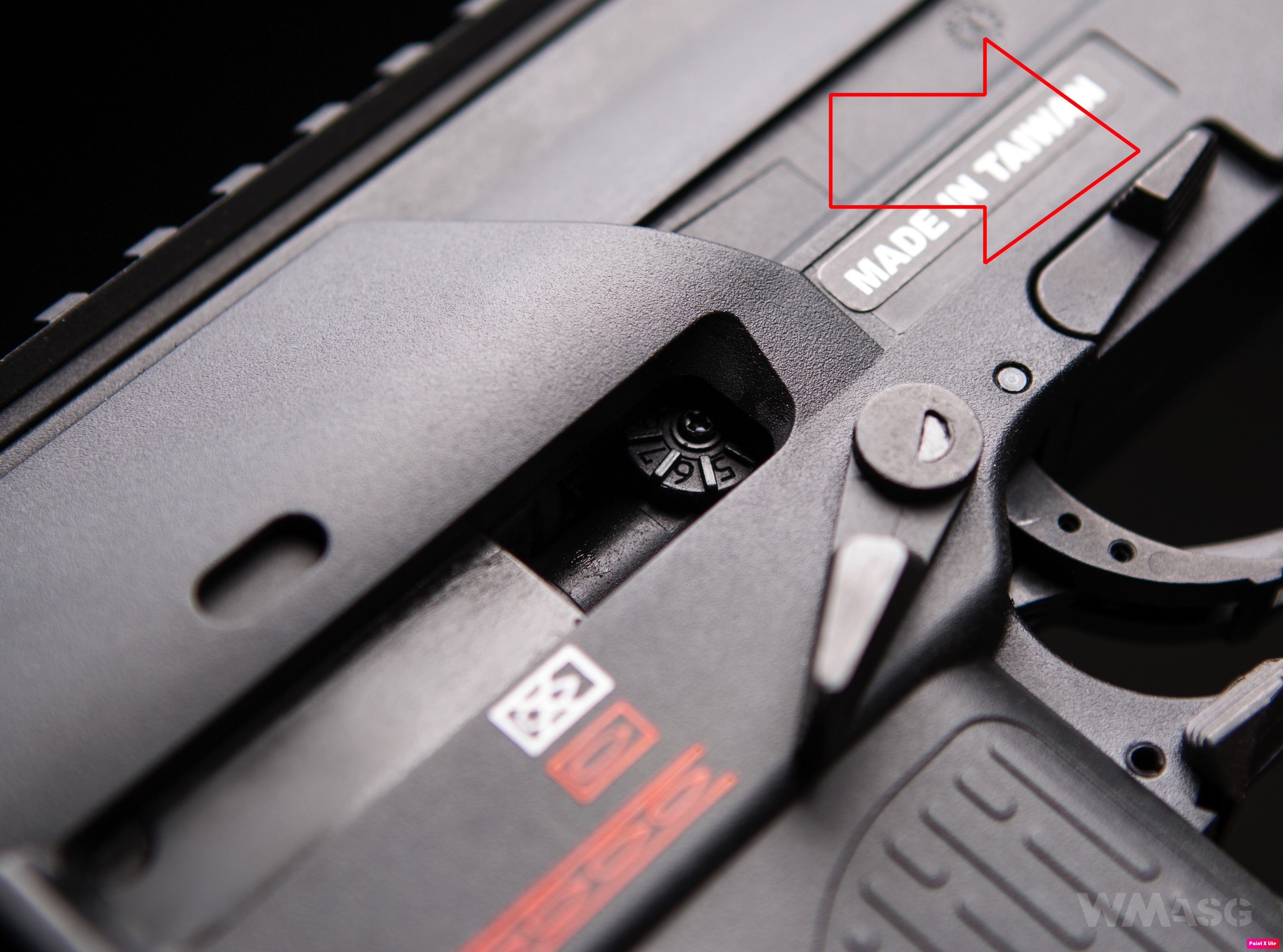
The stock, whose adjustment method I have already described, has 2 metal guides that move on the replicas receiver. There are 4 settings of the stock's length: 2 extreme ones (collapsed and completely extended) and 2 intermediate ones. On both sides of the butt plate made of polymer (not rubber), additional loops for mounting a carrying sling have been placed (although there are already 4 on the receiver). There are also 2 holes in the butt plate, probably intended for temporary storage of the pins securing the back plate of the receiver. However, the diameter of the holes is too large and the pins fall out.
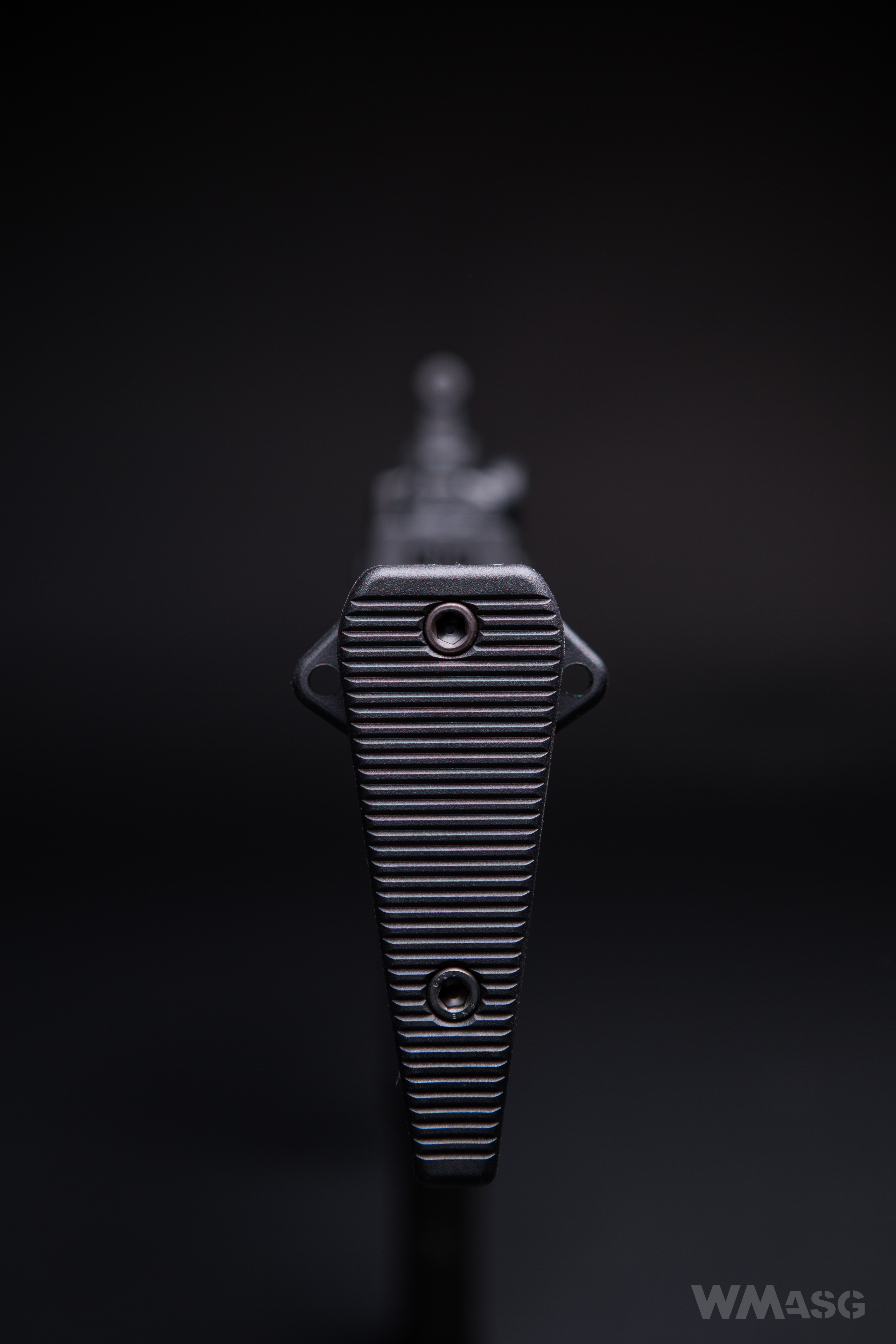
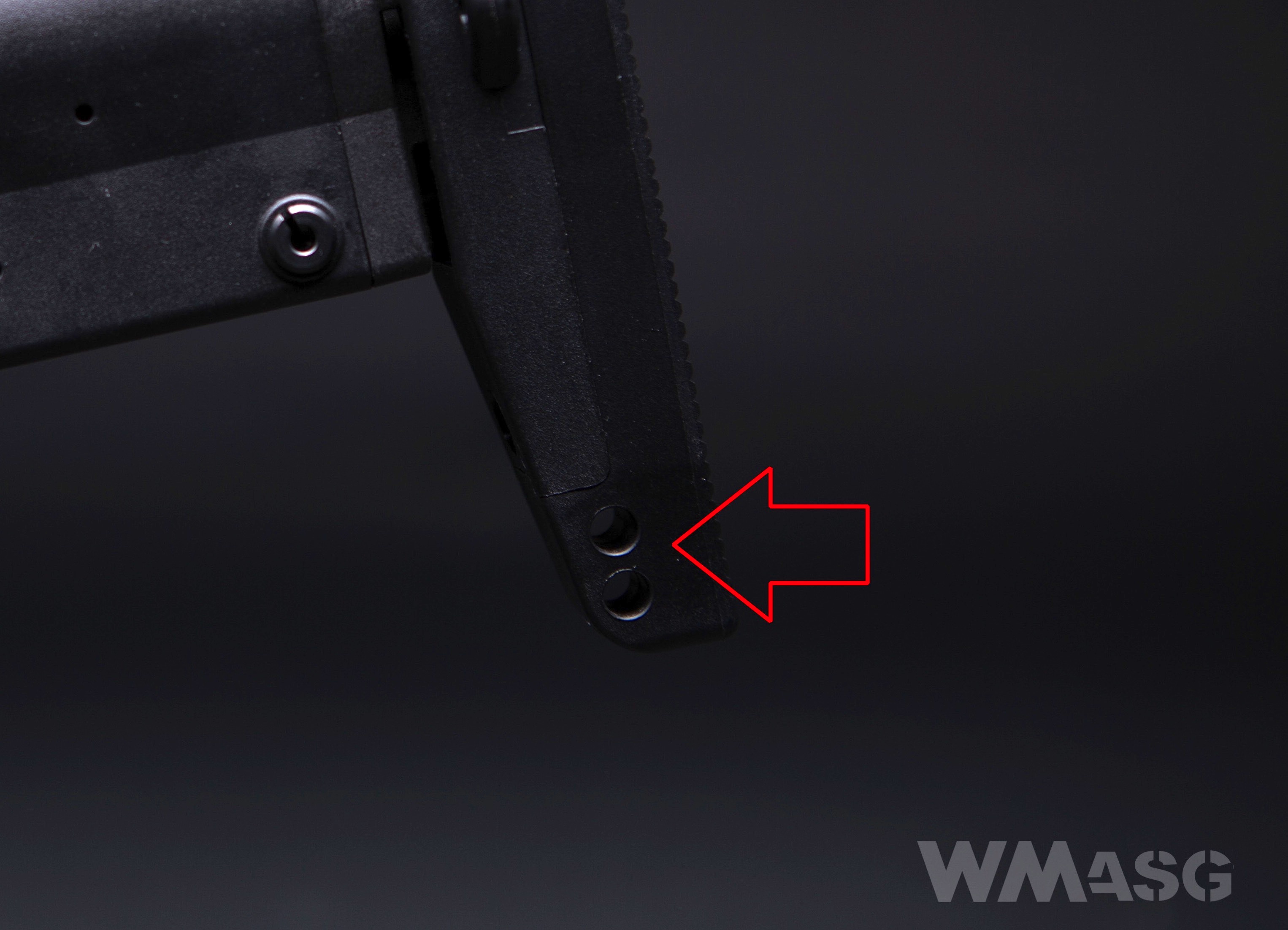
In the front part of the SMG there are holes with steel threads used to attach the rails for mounting accessories.
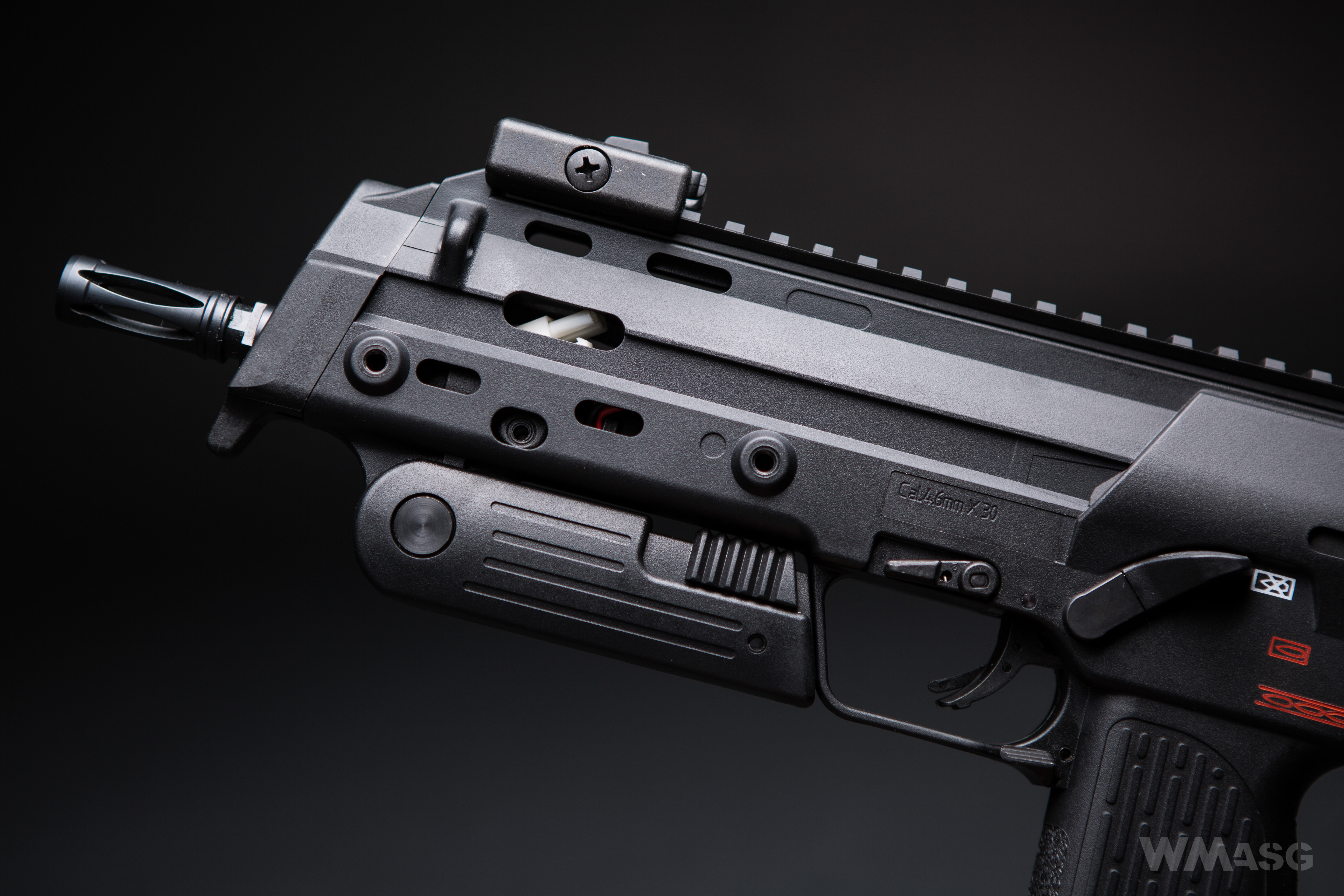
They are meant for installation of short 6-slot Picatinny rails. The rails are included with the real SMG. The replica does not come with them.
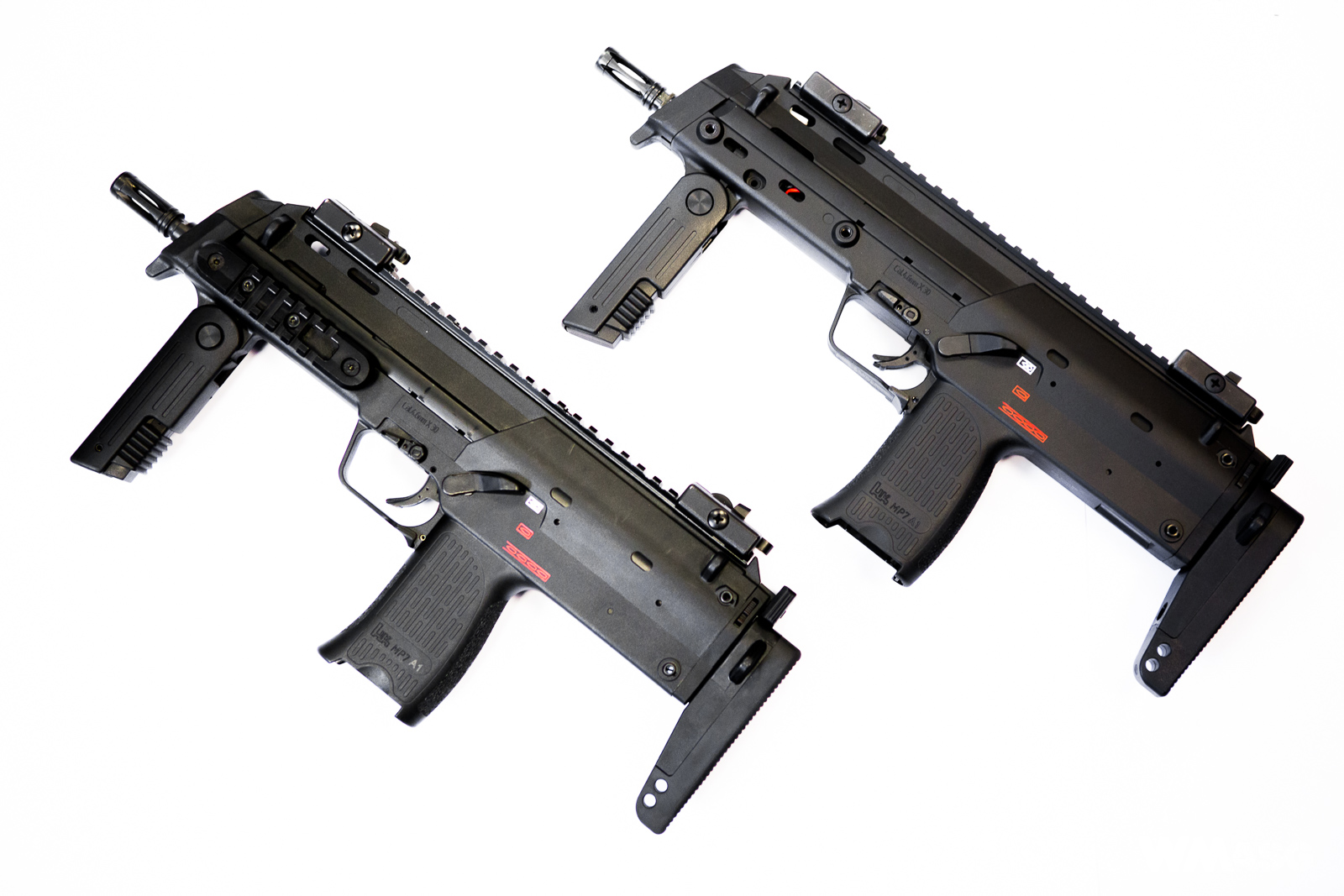
The visible folding vertical grip is made and works almost like the one from the real firearm. It has only a slight slack on the locking latch. The front edge of the handguard, just before the grip, is shaped like a hand stopper, which is to prevent uncontrolled obstruction of the barrel outlet.
The handguard also acts as a battery compartment in the replica. On several photos above, transparent wires can even be seen through the ventilation holes. Access to the compartment is obtained by removing the front closing plate. The locking latch is located at top (red arrow). The entire plate should be slid from the replica towards the barrel outlet.
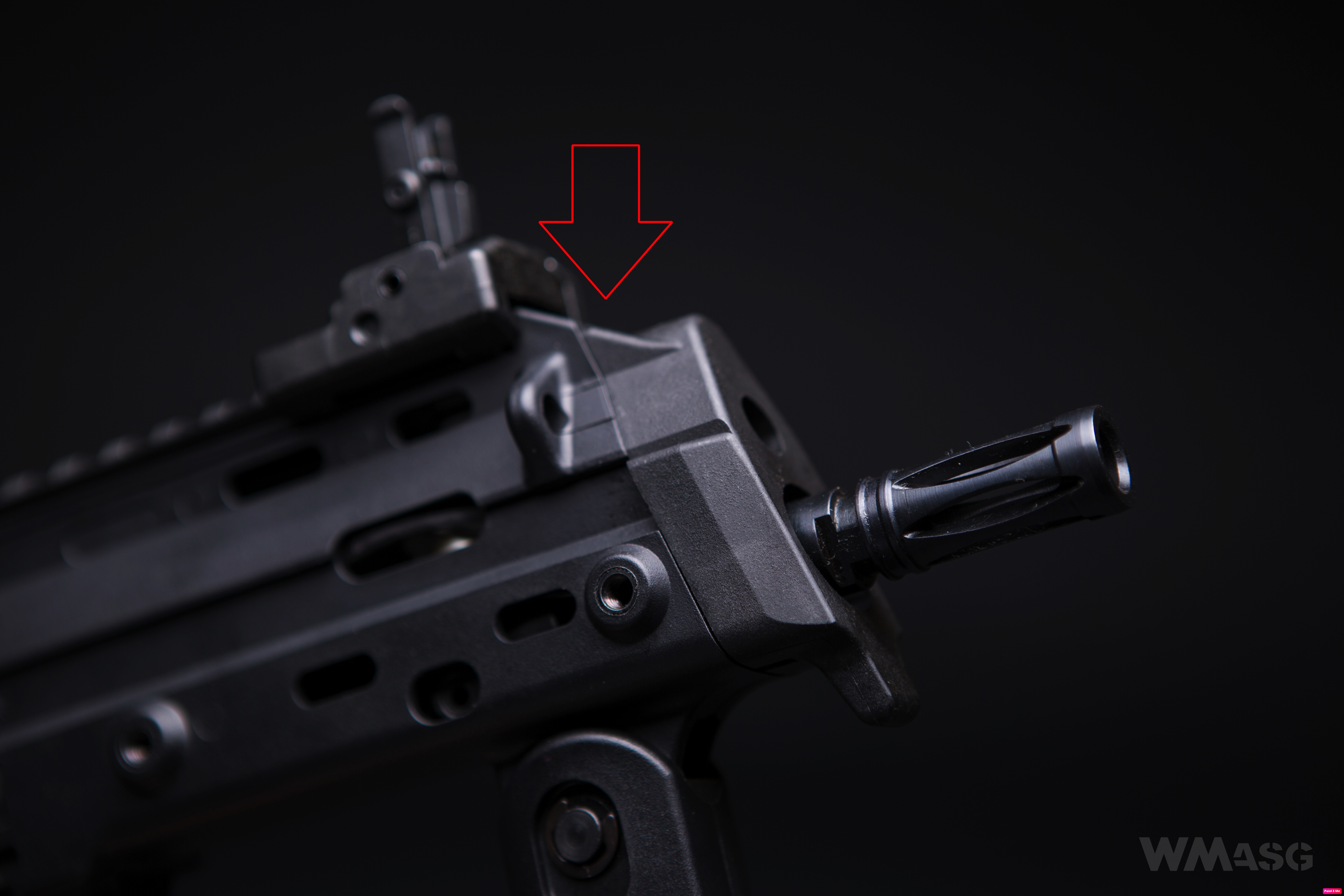
There is not much space for the battery, but it is enough to easily fit an 11.1V LiPo pack with a capacity of about 1200 mAh. The replica is equipped with a mini Tamiya plug. The flash hider shown above is made of steel and is fixed using a right-hand (CW) thread with a diameter of approximately 11.3 mm.
The sights turn out to be a class for themselves. First of all, they can be easily disassembled. Secondly, they can be used in both position, that is while being folded, as low profile sights and when unfolded. When folded, the trapezoidal front sight is fixed and the rear sight can be adjusted horizontally. In the extended position, the front sight can be adjusted vertically and the aperture rear sight can still be moved horizontally. Below, the folded sights:
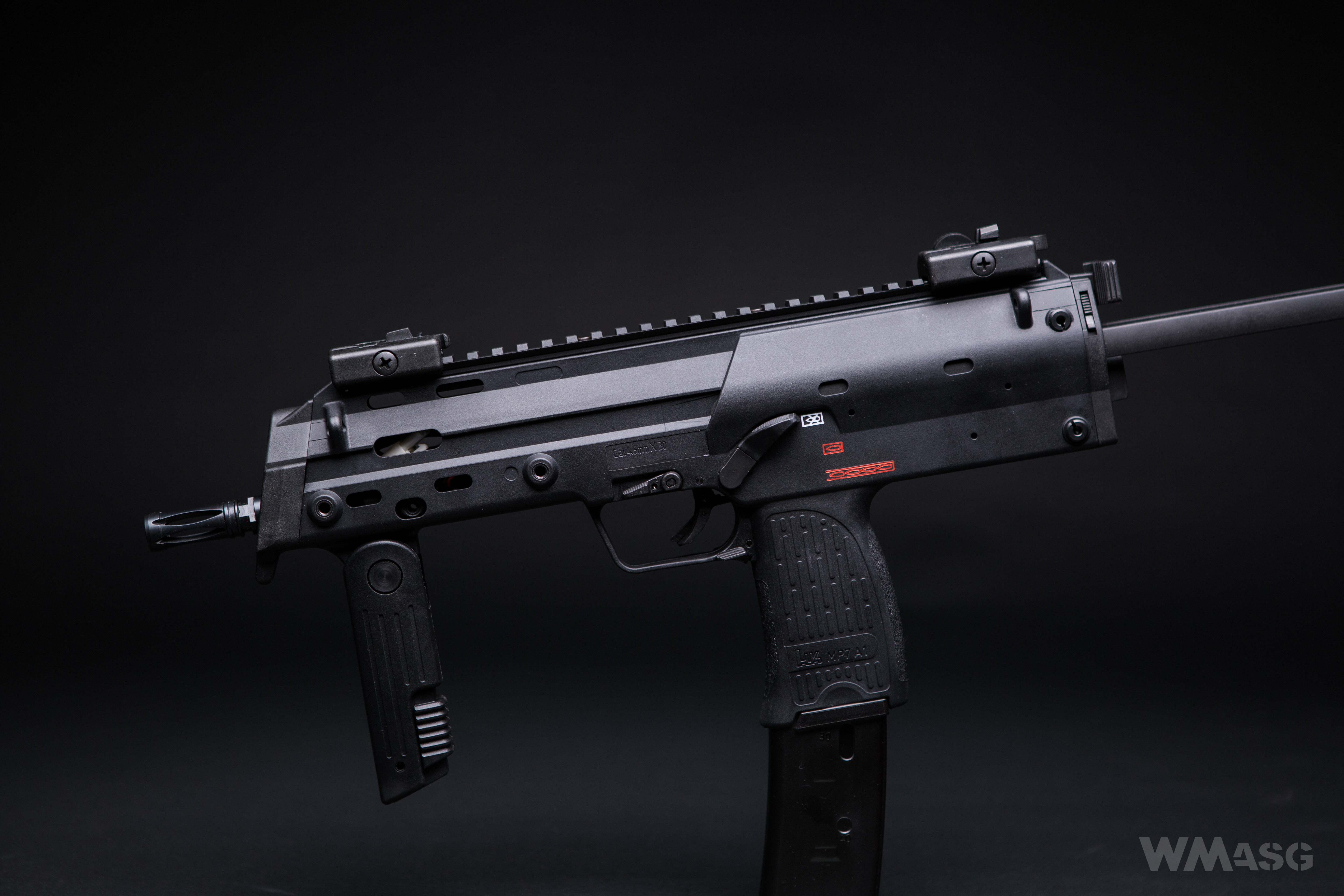
And the unfolded sights:
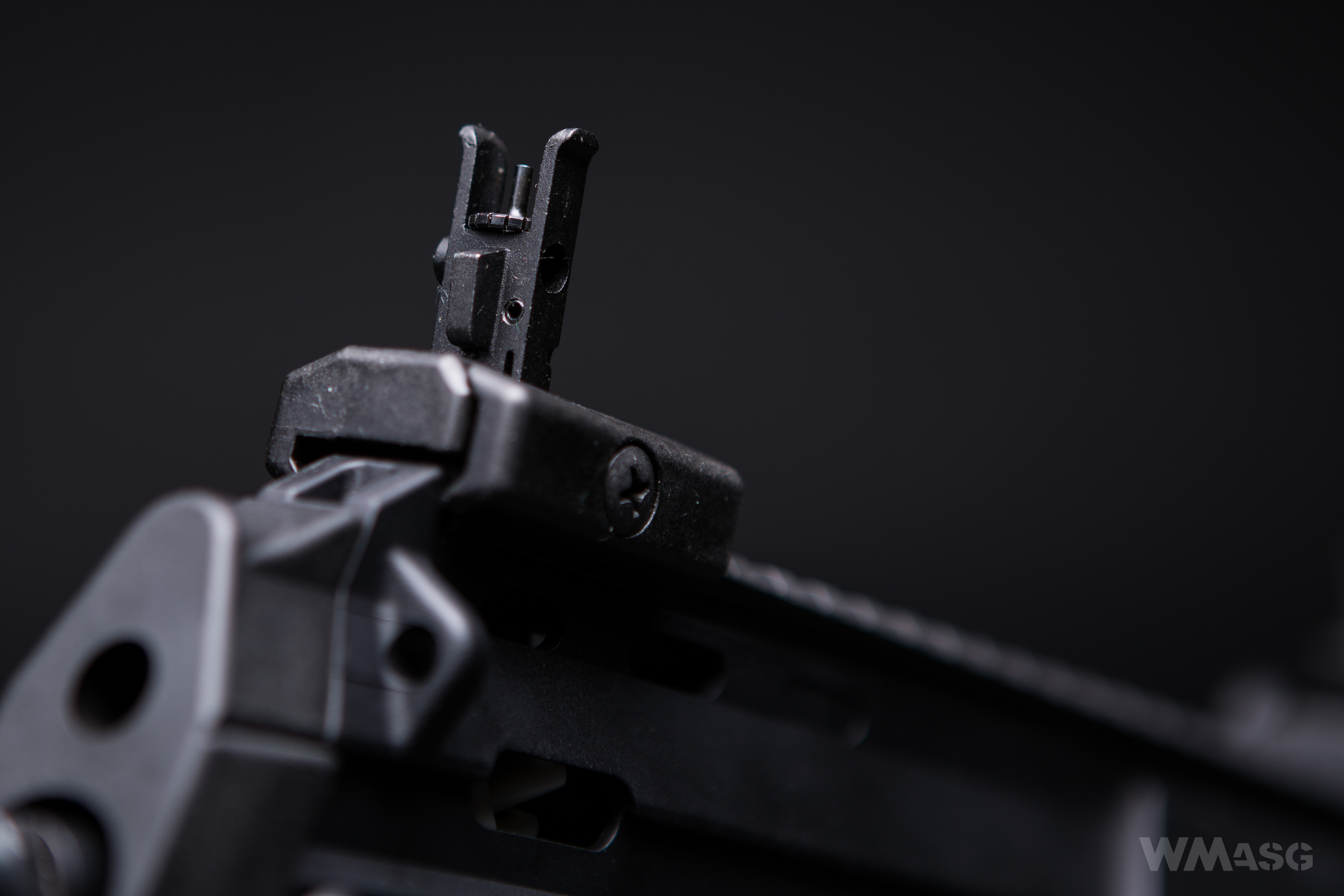
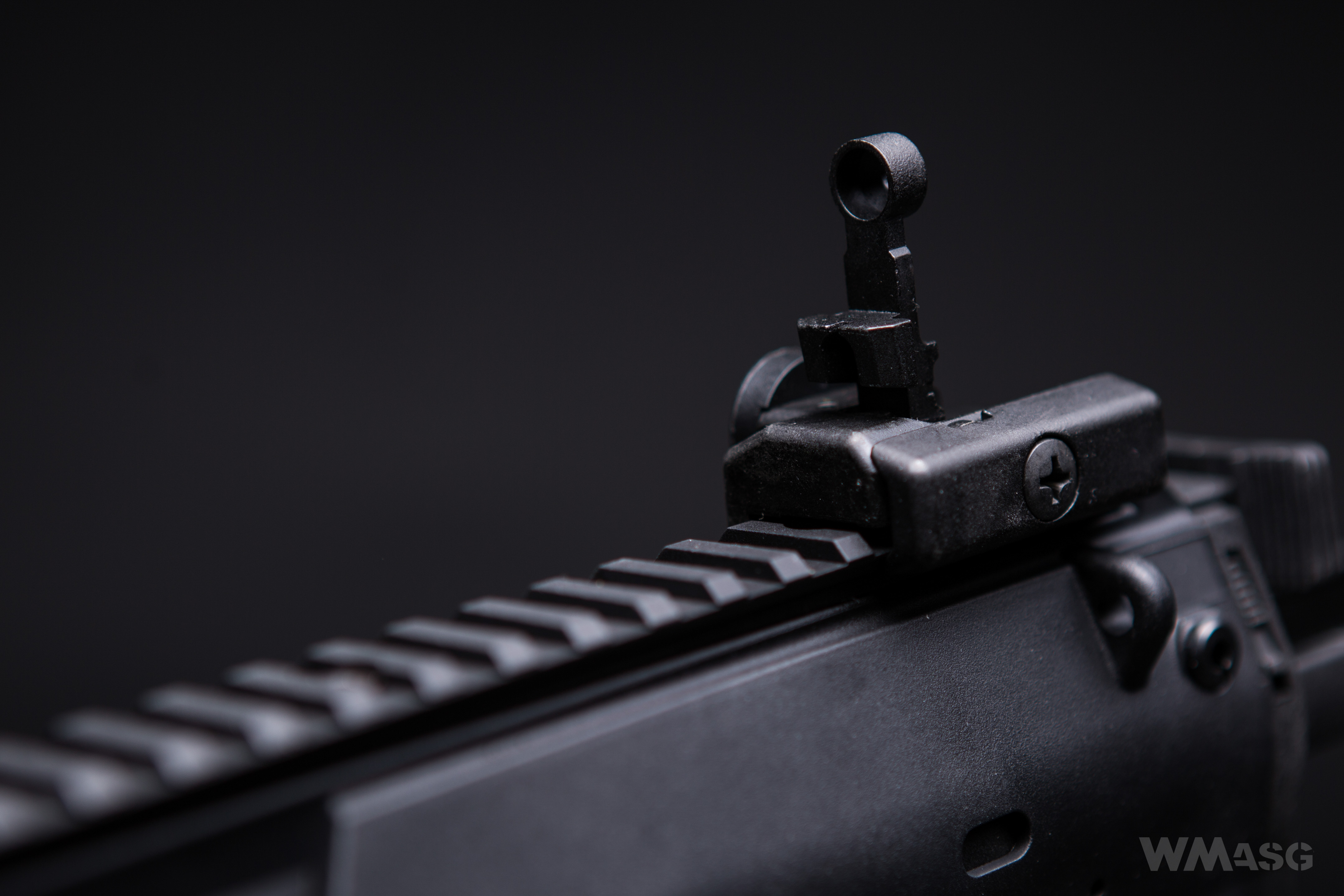
The magazine
The mid-cap that comes with the replica is entirely made of polymers. The magazine has a high protruding BB pusher, in which the magnet responsible for cutting off the power after firing the last BB is embedded. The whole magazine sits in the slot very firmly, but after pressing the magazine release falls under its own weight. During the tests we did not have the slightest trouble with feeding. In comparison with the real magazine, the airsoft version is slightly wider in the part hidden in the pistol grip and slightly shorter (the real one is on the right).
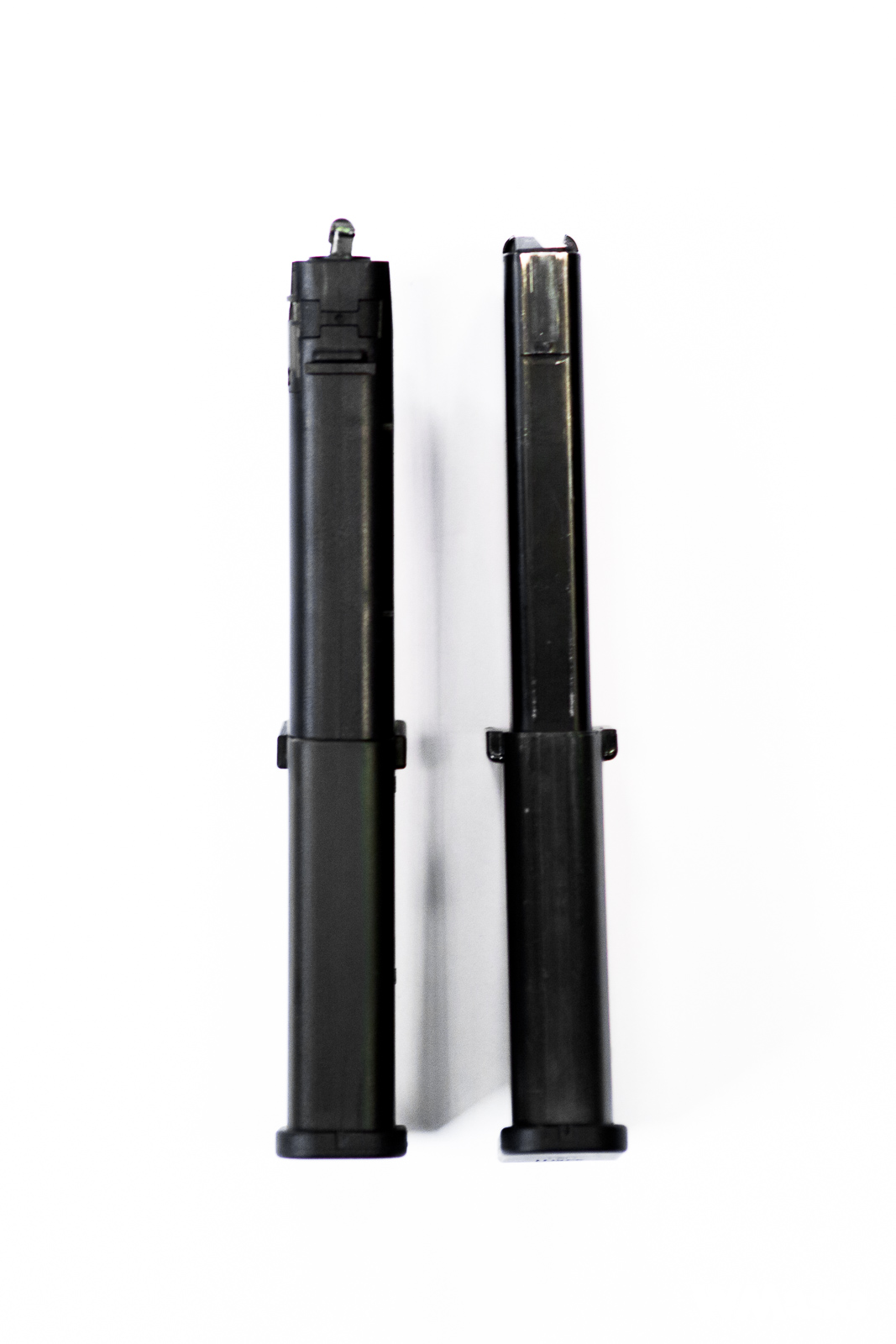
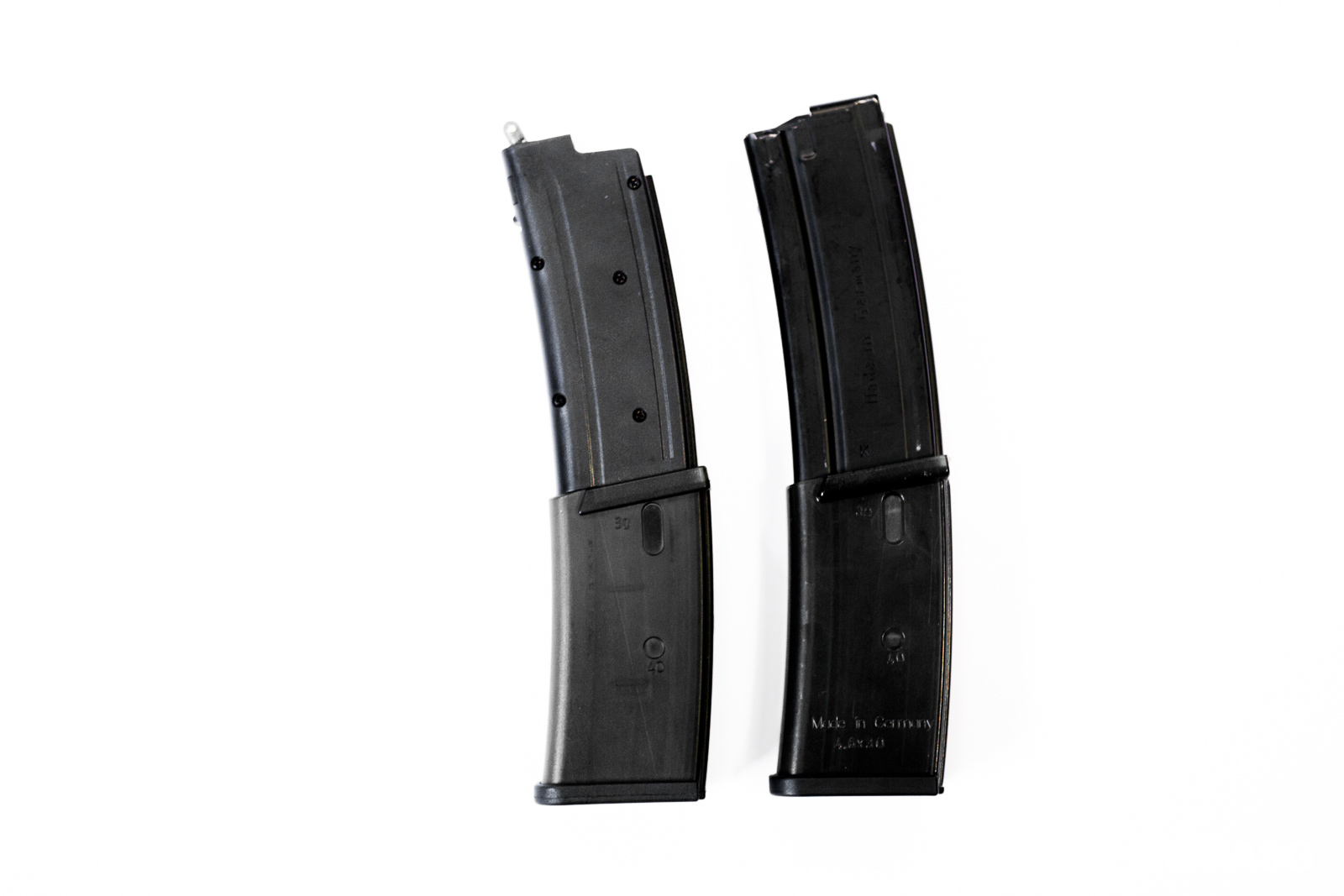
Zrobić zdjęcie w terenie - brakuje dobrego zdjęcia magazynka!
The mechanism
The mechanism used in the replica was created specifically for this project. The method of its disassembly is not particularly complicated, but tight fitting of individual parts does not make the task easier. In my opinion, this is one of those replicas that are not worth/shouldn't be disassembled while they work. The replica is used a dedicated gearbox frame in which a set of 4 gears work. The control system uses an electronic circuit with a MOSFET, delicated SMD micro switches and one Hall sensor. The mechanism is very cleverly engineered. But it is very complicated and quite demanding to assemble. Additionally, the parts used open a completely new standard, therefore the availability of spare parts is and will be limited for a long time. In the photo below, the internal module of the replica has been removed and partially dismantled. The gearbox, the motor mount and the inner barrel casing are joined together and removed as a single part from the receiver.
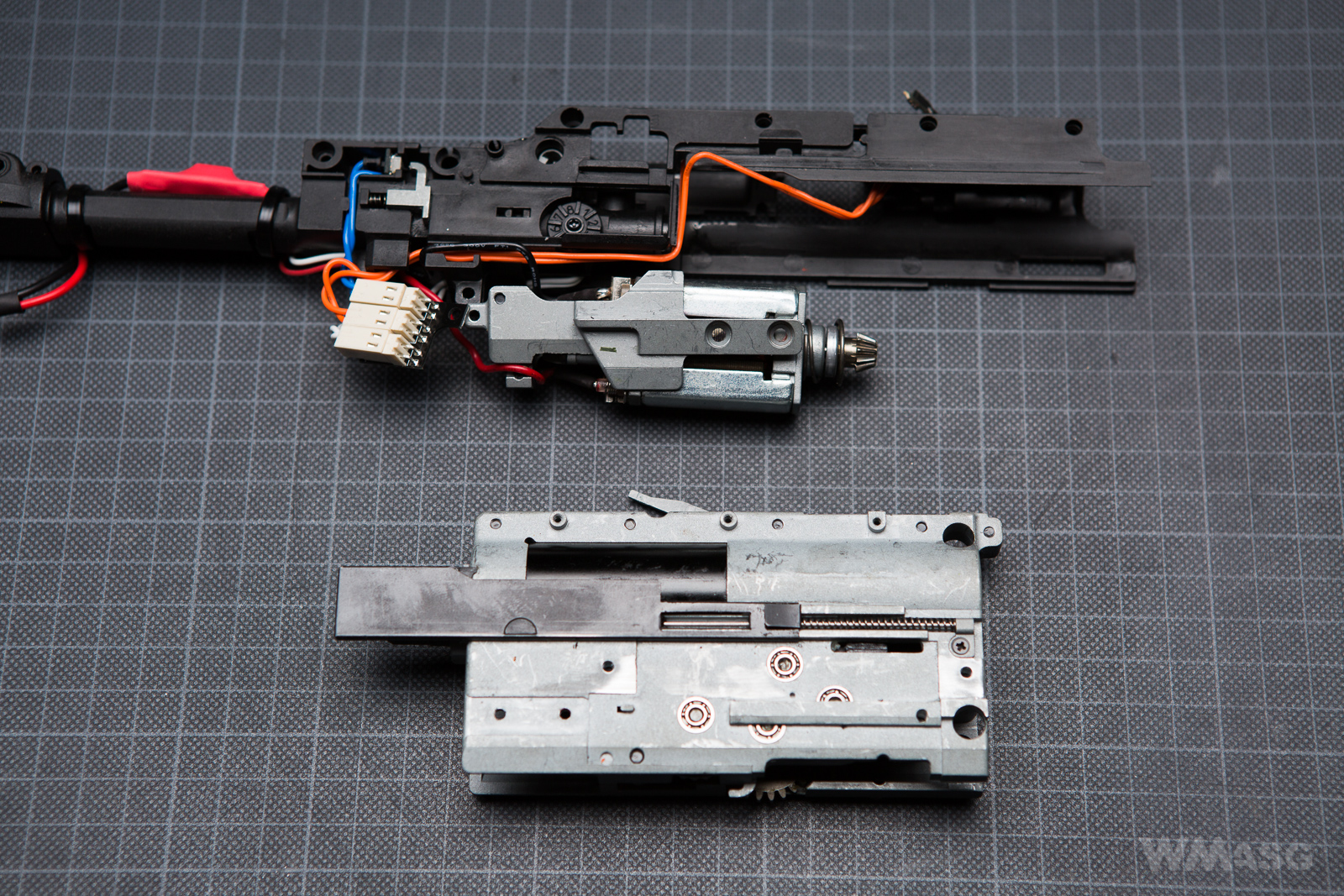
In the Internet there is information that the MP7 is equipped with a quick spring change system. It is in fact true, you can replace the spring without opening the gearbox. The problem is, however, that to do this one has to remove the whole internal firing from the replica's receiver and disassemble it slightly. And then ... see above. However, if someone really wants, it is possble:
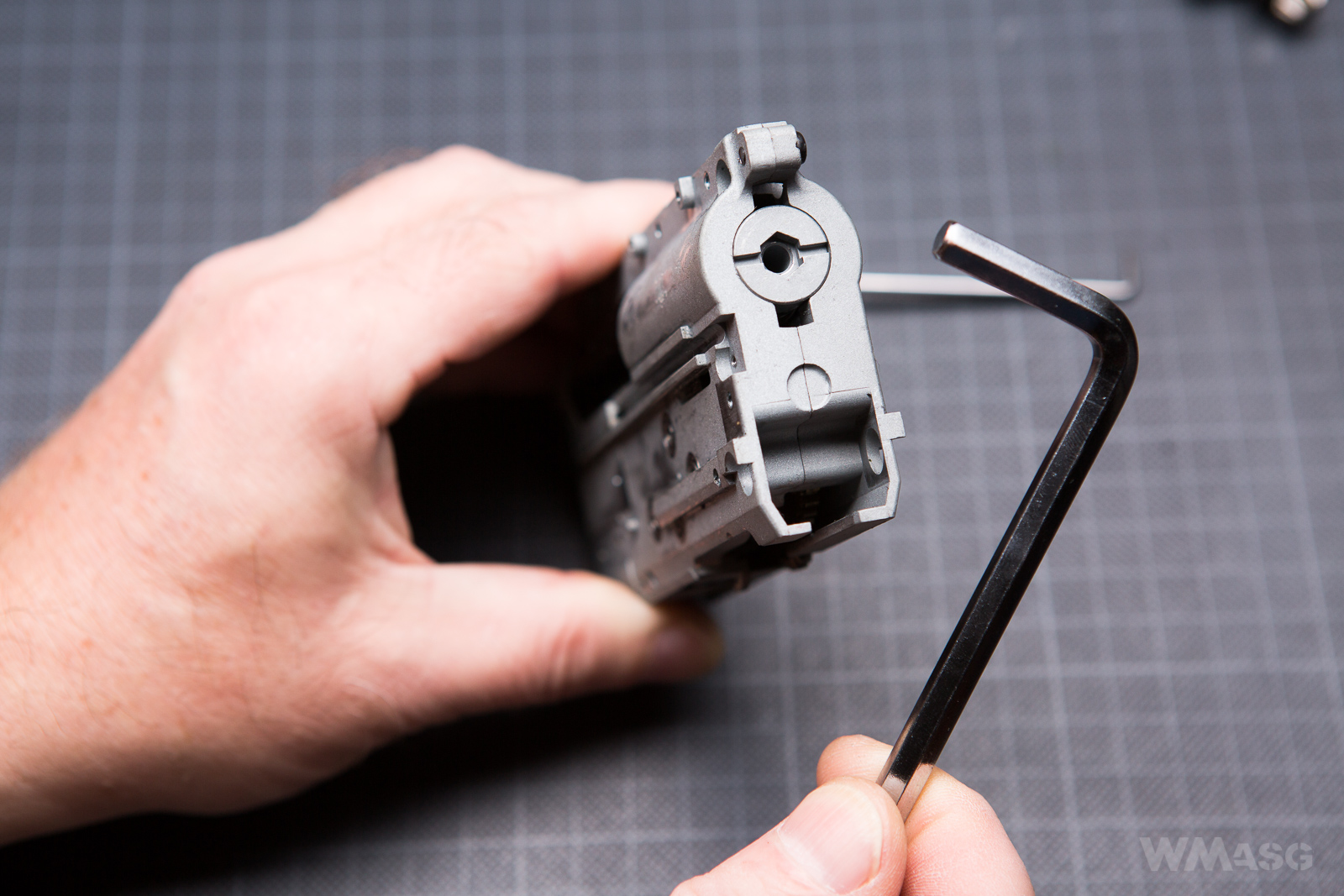
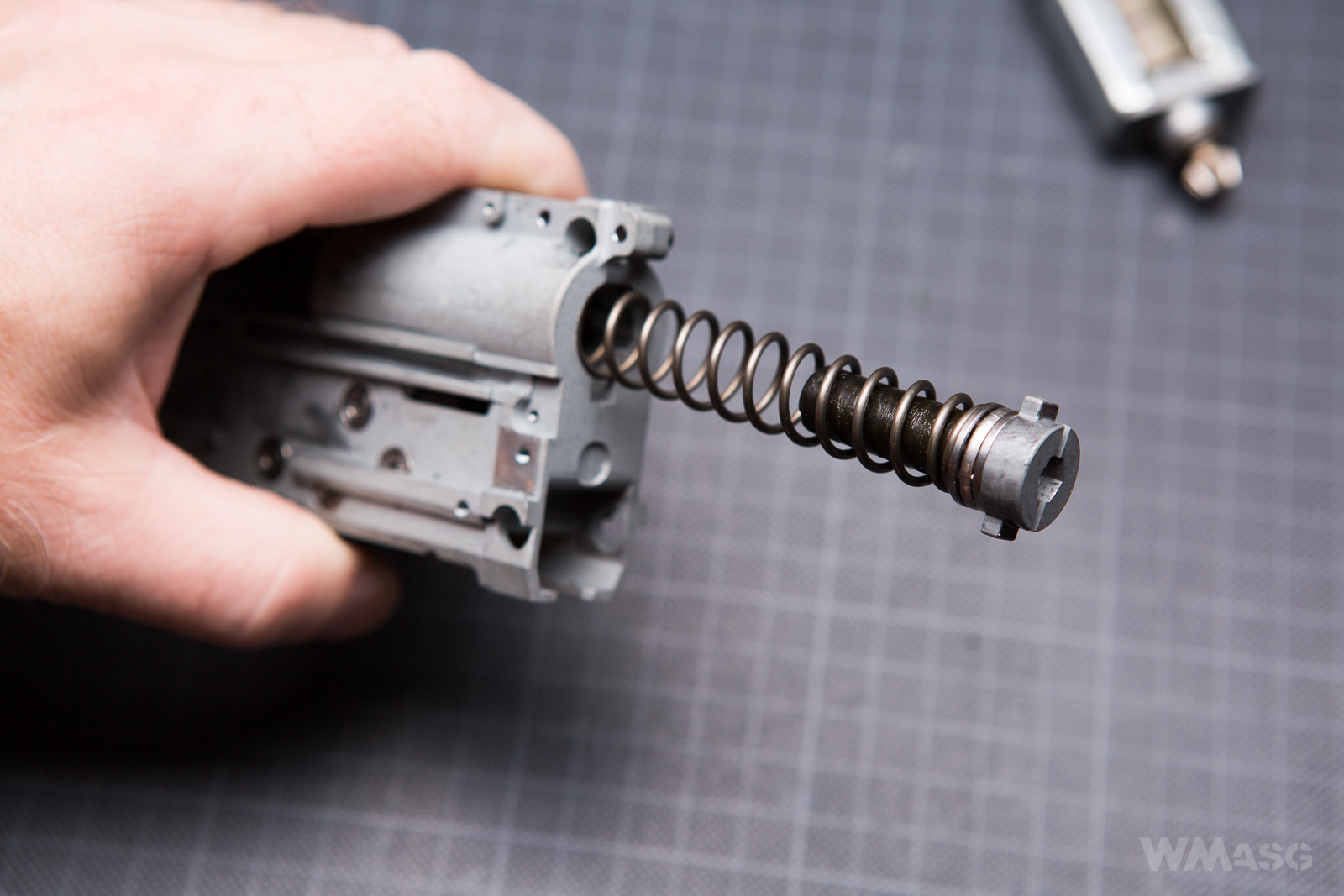
Inside the gearbox:
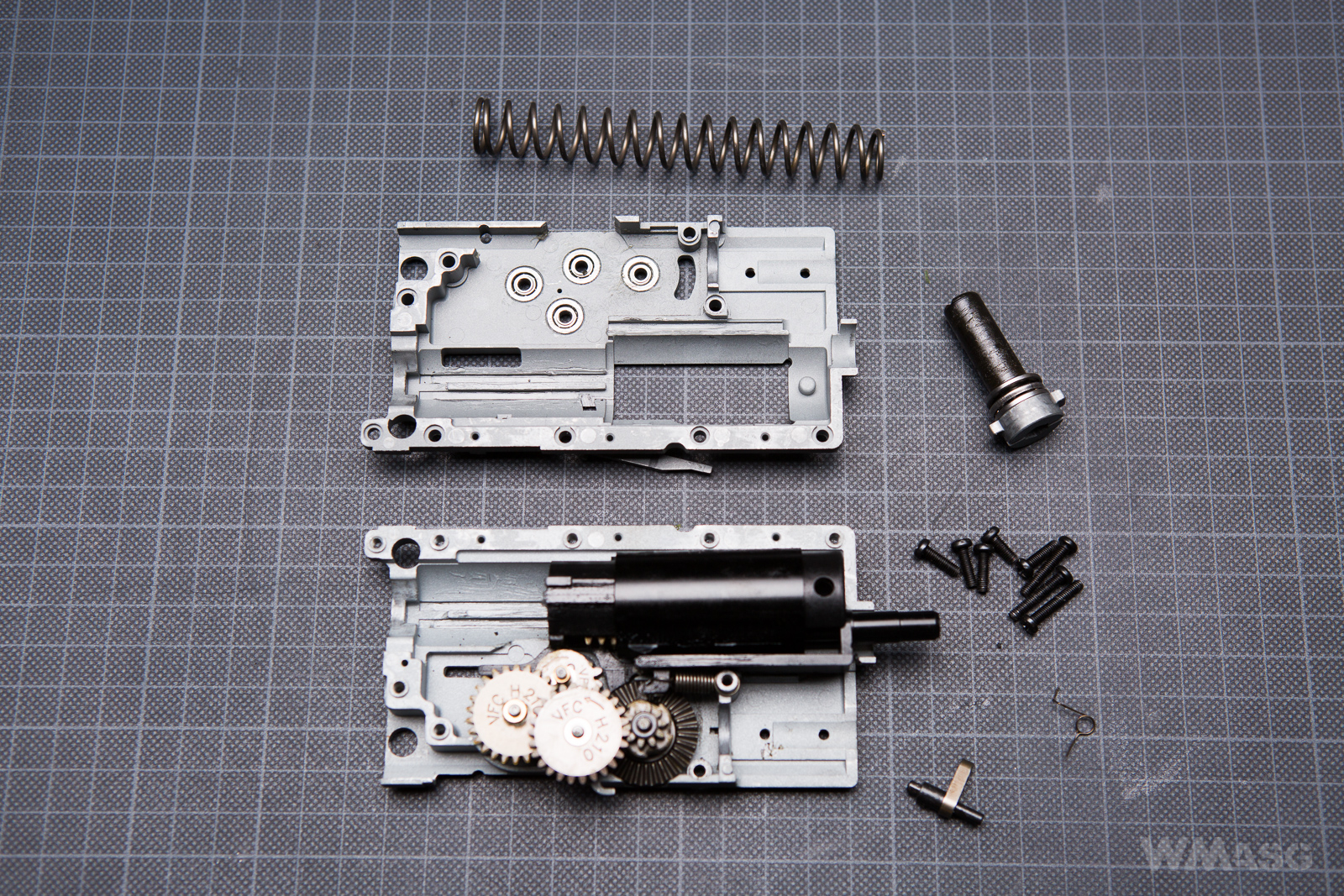
Note the lack of any wires or switches. Everything is mounted outside on printed circuit boards. Here, only clever levers enter the mechanism.
More technical details will be described later.
Target shooting test and muzzle velocity test
While shooting, the already mentioned incredibly smooth performance of the replica is noteworthy. It doesn't shoot, it's ticking like a clock. Of course, to some extent, this is due to the relatively low muzzle velocity (spring hardness). But the sound is still impressive. Earlier, I also praised the sights. During tests, it turned that the folded sights are not all that comfortable to use as they force to adopt a more compact posture, placing the aiming eye very low. It is much more comfortable to shoot when the sights are unfolded.
The test was carried out on our own enclosed shooting range, at an ambient temperature of 17°C, the Hop-Up was set to zero. The muzzle velocity measurements were made with the XCORTECH X3500 chronograph using 0.2 g Open Blaster BBs. The replica was powered by an 11.1V 1100 mAh LiPo battery.
The measures rate of fire: 22 rps
Measurement results:
1. 306.1
2. 309.4
3. 306.9
4. 306.4
5. 306.6
6. 306.4
7. 298.3
8. 299.3
9. 297.9
10. 298.8
Average: 303.6 fps
Spread: 11.5 fps
The measurement results surprised us a bit. Based on information found on the Internet, we expected around 330 fps. But ... the copy we tested does not come from European distribution. In addition, it seems to us that this replica has been tested by someone before. This could explain the lower than expected muzzle velocity and a slightly too wide spread. According to data from Polish stores, the European version of the MP7A1 should have around 330 fps (e.g. Militaria.pl). In turn, the twin Elite Force/Umarex replica, available in the United States, has a muzzle velocity of 370 fps. This result has been confirmed by video reviews.
Target shooting test (Hop-Up has been adjusted, using 0.25 g G&G BBs)
Single fire (5 cm spread)
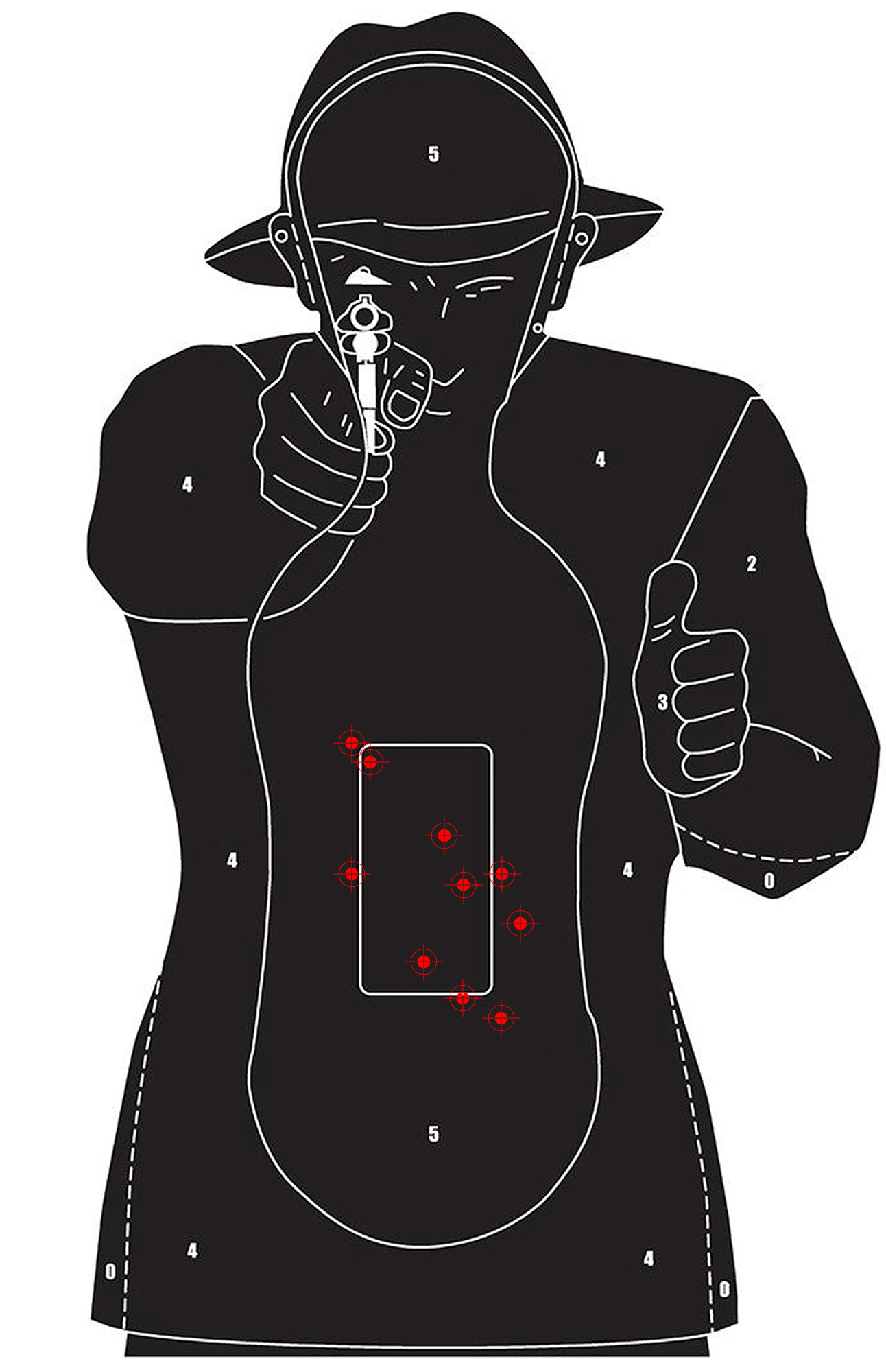
Full-auto fire (8 cm spread):
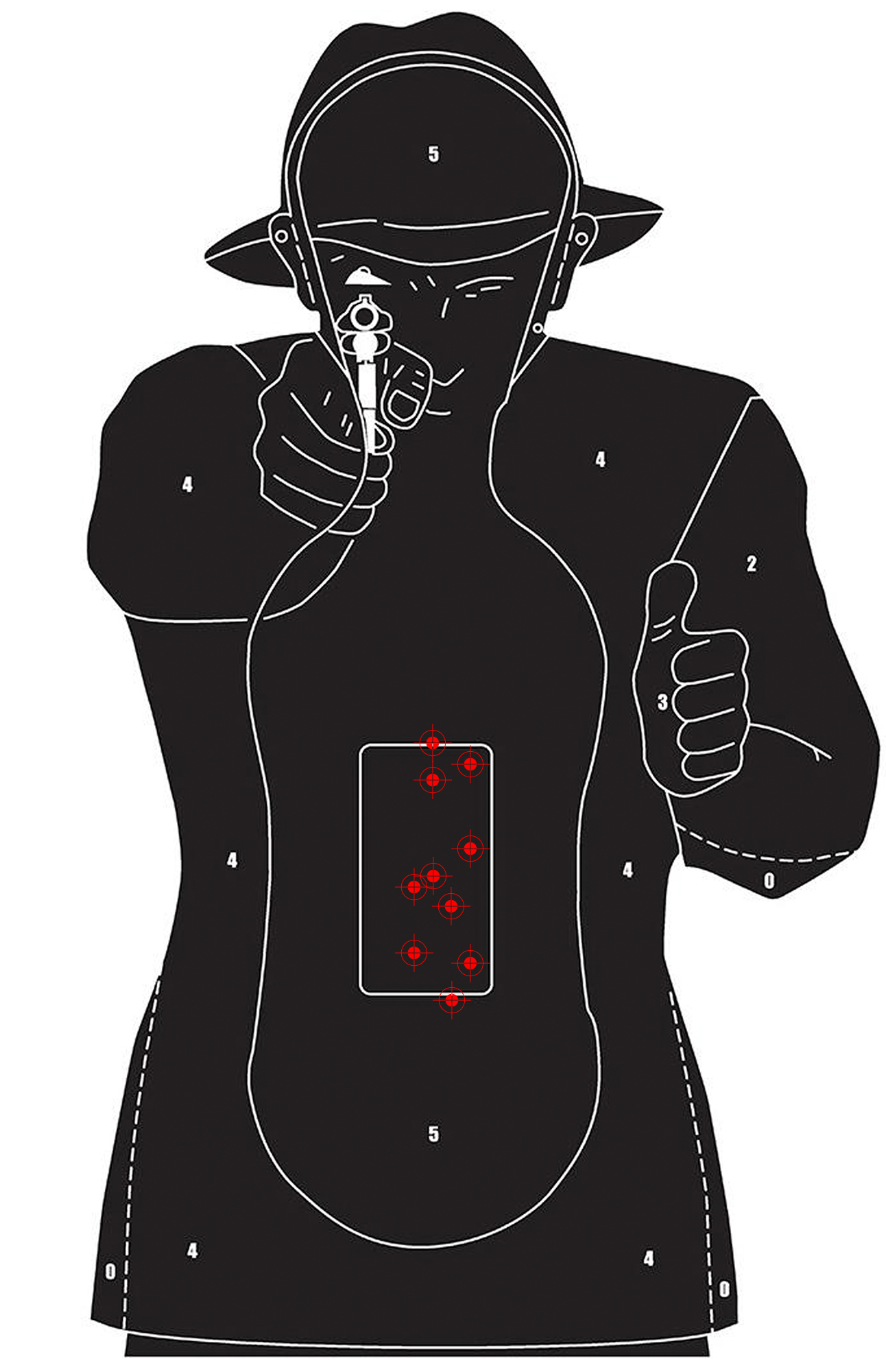
And one more information about target shooting test. On our standard range, 25 meters, all the BBs hit the targets but could puncture it. The results presented above were obtained by reducing the distance from the target to 15 meters.
Summary
Visually, no critical remarks can be made. Color, texture, markings, everything is perfect and imitates the real SMG very well. You will judge it yourself best by comparing both the replica and the real gun in the gallery attached to this text (NOTE: THE REPLICA IS THIS ONE WITHOUT MOUNTING RAILS AT THE FRONT).
Functionally its also a blast, although people who will be dealing with the replica for the first time will have to get used to that fact that it cuts off the power supply after emptying the magazine. It is troublesome at first, even when someone is usually playing using real or low-caps. But after a while it becomes a second nature. There are some criticisms on the web that the replica is a failure. Despite intensive attempts, we have not managed to damage our MP7.
So would I buy such an MP7A1? For many of us, the price is one of the key factors when choosing a replica. And this version of the MP7 is not cheap. In addition, a complete move beyond the standardized parts makes tuning very difficult. But if I needed a replica solely for CQB or just to play under set and enforced muzzle velocity limits? I could be tempted. And it would be the first replica in which I would not intend to replace anything at all.
On the next page: technical details for those of you interested.
Links to the photo galleries can be found at the top right of the page.
Information about the real MP7A1 taken from: HK MP7 Ireneusz Chloupek/SPECIAL OPS 6/2016 / 30-01-2017 link:http://www.special-ops.pl/artykul/id784,hk-mp7?p=1
Big thanks to Vega Force Company for help with this article
Big thanks to Cenzin sp. z o.o. for help with real steel HK MP7




